KILLED BY CARDBOARD
How old-growth forests in Sweden end up as boxes for global e-commerce

Nature crime files
SWEDEN

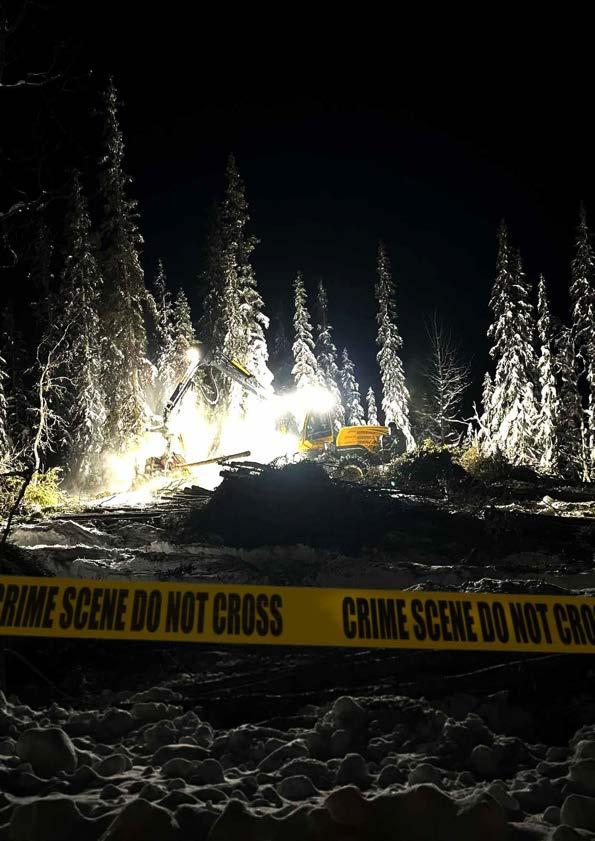
Every day in Europe, life is turned into death, but the perpetrators go unpunished. These crimes are not committed with guns or knives, but with chainsaws and bulldozers. These “nature crimes” are happening legally. When the forest industry destroys vital nature for wood products, the governments look the other way. The consumer becomes both a victim and an accomplice.
Centuries-old forests in Czechia, Carpathian forests in Romania and Poland, and the boreal forests of Sweden and Finland – all central to Europe’s fight against the climate crisis – are being turned into short-lived products and sold across Europe. While presenting itself as a progressive defender of biodiversity and the environment, Europe is actually doing little to stop corporate greed and corruption from destroying both. The following case is part of a series that we have called The Nature Crime Files –Declassified , a clarion call for proper protection of ecosystems, which are the basis of our life.

May 2024, Greenpeace Nordic, corrected version 1.2
2 3 KILLED BY CARDBOARD • NATURE CRIME FILES – DECLASSIFIED, SWEDEN KILLED BY CARDBOARD • NATURE CRIME FILES– DECLASSIFIED, SWEDEN
Executive Summary 4 Introduction 7 Swedish Forestry and Biodiversity 7 Swedish Forestry and Climate 8 Swedish Forestry and Indigenous Peoples 8 Failure of Governance 10 Governance in Practice 10 Failure of Protection 11 Failure of Certification 14 FSC and Biodiversity 14 FSC and Indigenous Rights 16 The Role of the Pulp Industry 19 Greenpeace Findings 22 Step one: Forests to Mills 24 Step two: Mills to Markets 26 Main Market Sectors and Directions of Change 27 Conclusion: Responsibility is with the Markets 30 Eliminate Material That Originates From Clear-cutting of Old-growth Forests 31 Work Towards Better Regulation 31 Reducing Pressure on Forests – Shifting From Single Use to Reuse or Recycled 31 Endnotes 32 Appendix, Investigation Methodology and Result 37 CONTENT Cover image: © Greenpeace
Executive summary
Greenpeace’s Nature Crime Series of reports is designed to highlight the link between the ongoing destruction of Europe’s last old-growth forests, and consumer products found in homes, and worse, in bins across the globe.
In this report we focus on Sweden. We will share the results of research spanning more than a year, focusing on particularly vital, irreplaceable and important areas of forest that have been clear-cut mainly for the sake of paper, pulp and cardboard. We have identified two main drivers in the failure to protect endangered species and habitats:
• A failure of governance: It has been largely left to the forestry industry to self-regulate and decide which areas of forest can be logged and how . The obvious conflict of interest means that companies buying pulp, paper or other products derived from the wood, are being misled.
• A failure of legitimate, verified certification: As a trusted consumer guide to ethical or sustainable sourcing, the FSC and other certifying bodies are also self-regulating, they are inextricably bound to the forestry industry through financial systems and organisational crossover. Certification of products should have certain guarantees. In practice these are false.
The timber from the Swedish forests is primarily destined for manufacture of pulp, paper and cardboard used in products marketed around the world. Given the inability of governance and certification systems to prevent forest destruction, we turn to the companies that purchase pulp and other wood products from Swedish producers with a call to utilise their buying power to change these systems and ensure the labels consumers rely on when making purchasing decisions can be trusted. If profit is driving the destruction, then it might also drive change.

We conducted the investigation presented in this report in order to get a glimpse into the largely intransparent chain of custody that leads from the old growth clear-cuts in Sweden to the consumer companies around the world. We established links to over a hundred companies at risk of receiving material that originated in unsustainably logged forests of Sweden.
The investigation was carried out in two steps: The first step traced the route that timber takes from the clearcut to the pulp mill. This was done by a remote-sensing analysis and field work. The tracing of timber was performed by a combination of following timber trucks and by using electronic tracking devices. More than 60 logging sites were visited, and the logged timber was followed to its destination at 9 pulp-and-paper mills, operated by 6 different companies, including such well known names as Smurfit Kappa, SCA and Billerud.
The second step in the research was to describe the links between the operators of the pulp-and-paper mills identified during the first stage and the companies that receive their product. This was conducted by online research, analysing statements made on company websites, information harvested from social media posts, presentations made in industry fora and similar. Additional information was gathered from certification and RESY codes on packaging collected in a number of consumer countries.
We then contacted the companies identified in the second phase of the research in order to offer them an opportunity to confirm or correct our findings. We established links to almost two hundred companies
in Europe and beyond, including such global brands as Zalando, Amazon and HelloFresh. The full details of the results of the investigation are presented in the appendix to this report.
The report is designed to inform the consumer companies of the risk that their supply chain is exposed to, and to offer suggestions for steps that they can take in order to eliminate it by:
• Cleaning up their supply chain from old-growth forest material.
• Actively supporting stronger EU nature-protection regulation in order to avoid such critical issues in the future.
• Working towards eliminating the use of single-use packaging.
These steps are concrete and not over-burdensome. They do not require the companies to stop buying wood from Sweden. Neither do they call for a boycott of the Swedish pulp-and-paper mill operators who are shown to have received material from old growth forests. The recommendations are detailed in the concluding section of the report.
It is our starting assumption that the recipients of material from Swedish old-growth forests are acting in good faith, and are unwitting victims of the relentless greenwashing that the Swedish forestry and pulpand-paper industry carries out. This report offers a view from the ground and tools for meaningful action.

4 5 KILLED BY CARDBOARD • NATURE CRIME FILES – DECLASSIFIED, SWEDEN KILLED BY CARDBOARD • NATURE CRIME FILES– DECLASSIFIED, SWEDEN
© Greenpeace

Introduction

Sweden is home to some of the largest areas of biodiversity-rich forests in Europe.1 The total forest area of Sweden is 28 million hectares (ha) (23.5 million is productive forest and 4.6 million is non-productive, that is, forest that is not suitable for commercial logging), which corresponds to almost 70% of the total land area of Sweden and more than ¾ of the total area of Germany.2 As of 2023, the ownership of productive forest is split among large corporations (24.9%), the state, including municipalities (20.3%), private forest owners (48.6%) and other bodies, such as the Church and cooperatives (6.2%).3 Of the 23 million hectare productive forest land, approximately 6% are formally protected.4
Large corporations own a quarter of Sweden’s productive forests. These are often companies that also own processing facilities such as saw mills or pulp and paper mills. They conduct forestry operations in the forests they own as well as in the forests owned by others. Often they will offer logging services as part of a contract for purchasing the timber from a forest owned by others, individuals or companies.They work with other companies that offer logging services in contracts for timber.
Swedish Forestry and Biodiversity
These prevalent forestry practices have had and continue to have a negative impact on forest biodiversity. A study by the Swedish Species Information Centre, at the Swedish University of Agricultural Sciences,5 found that “the form of forestry, in particular clear-cutting, is judged to be the factor with the strongest negative impact on the forest species”
The Swedish Environmental Protection Agency also sounds the alarm. In their 2023 evaluation of the progress towards reaching national Environmental Quality Goals for forest biodiversity (‘Levande skogar’), the agency notes that the measures taken so far: “Are not sufficient to halt the loss of important habitats in the forest landscape… The loss has a major negative impact on Sweden’s ability to preserve biodiversity in the forest landscape and reach international goals.”6
The prevalent forestry method used in Sweden, is based primarily on clear-cutting areas of forest followed by soil preparation and replanting. It is also standard practice to conduct thinning operations between periods of clear-cuts.
These negative effects are particularly devastating when the logging is carried out in natural forests. In 2011 the Species Information Center report found that Sweden has lost 60% of natural forests since 1950, and these were replaced by production forests. The report concludes that “The reason for the fact that three out of four red-listed forest species decrease is the conversion of continuity forests7 to production forests” 8
Meanwhile, clear-cuts in old-growth forests are happening at a relentless pace. A 2022 study shows that sufficient measures have not been taken to protect them, concluding that “At least 19% of all clear-cuts since 2003 have occurred in old forests that were most likely not previously cut and planted or seeded. Old forests have been cut and lost at a steady rate of 1.4% per year for the same period ,
7 KILLED BY CARDBOARD • NATURE CRIME FILES– DECLASSIFIED, SWEDEN
CORPORATE STATE PRIVATE OTHER © Greenpeace
Figure 1. Forest ownership in Sweden.

and at this rate they will disappear by the 2070s.” 9
A Greenpeace analysis of logging notifications 10 submitted in the county of Västerbotten, a typical area for large-scale timber industry, confirms these figures. A review of logging notifications submitted over a 12-month period, based on a download from the Swedish Forest Agency database 11 showed that of the 12,531 notifications submitted between January 2023 and January 2024, 4,704, or more than a third, were within mapped continuity, 12 or old growth forests. 13
Swedish Forestry and Climate
The Swedish forestry model hinders forests’ ability to counteract climate change. Forests act as a carbon sink, capturing CO₂ from the atmosphere, and storing it in the biomass of the forest and in the soil. However, in 2022, a report by the Swedish Environmental Protection Agency14 concluded that the net storage of carbon in growing trees “showed a substantial reduction” for 2021. This decrease, say the authors, “is mainly due to declining growth in the forest and the high logging levels of recent years”. The authors conclude that “The sharp decline in net storage may mean that Sweden will find it difficult to reach the EU’s common climate goals linked to the land use sector.”
An annual statistical analysis released in 2023 by the Swedish National Forest Inventory provides background detail for this worrisome trend. While the annual increase of forest biomass is still higher than the loss, the difference is decreasing rapidly and is on the verge of reversing.15
The same trend can be seen in neighbouring countries with a forestry practice similar to Sweden. In Estonia, the forests already emit more greenhouse gases than they absorb, while in Finland, the amount of these gases that are absorbed by the forests has fallen drastically. In both cases, the researchers place the blame squarely on intensive clear-cut forestry. As Markky Ollikainen, a leading researcher succinctly summarises the causes of the trend towards the decrease of the carbon absorbed by the forests from the atmosphere: “The dominant hypothesis right now is that the reason is our very high harvest in recent years” 16
According to the Forest Research Institute of Sweden (Skogforsk), some 1,260 million tons of carbon are stored in standing and dead trees in Sweden’s productive forests.17 There is a huge difference between
the volume of carbon stored in old-growth forests compared to managed forest landscapes (with clearcuts, young plantations and thinned stands).18
An analysis of 10 international studies,19 concluded that a clear-cut emits about 16 tons of CO₂ per hectare to the atmosphere during the first year after logging. The emissions decrease over time, and it takes 10–15 years for a typical forest area in Central Sweden before the emissions have stopped and the area begins to function as a carbon sink again. It takes much longer for the areas to compensate for the initial loss of carbon, the study concludes.20 During this period the released carbon remains in the atmosphere as a greenhouse gas. The authors conclude that over a 10-year period Swedish clear-cuts “annually release approximately15 million tons of carbon dioxide, which is roughly the same amount as the entire [Swedish] transport sector.”
A counterargument one often hears from the industry is that logging increases carbon storage, by locking it in long term products, such as buildings and furniture, while new growth absorbs and stores more carbon from the atmosphere.21 This is a false picture. The majority of the material harvested in Swedish forest is destined for short-lived products, such as paper pulp or biofuels.22 The carbon stored in biofuels is released almost immediately, that stored in paper mostly within a few years, with nearly all (96%) of the carbon stored across all forest products being released within 100 years.23
Swedish Forestry and Indigenous People
Swedish forestry practices have had a significant negative impact on the traditional reindeer herding of the Sámi – the only recognised Indigenous People in the EU.24 Reindeer herding is central to the Sámi culture and traditions, and for many members of the group, constitutes an important economic activity.
Traditional reindeer herding is based on the use of natural pastures and organised in Reindeer Herding Communities (RHC).25 Reindeer herders follow the reindeer while they migrate between grazing lands and pastures. Seasonal migration is often between the mountains and the forest in spring, and the forest landscape where the reindeer seek shelter when the snow starts to fall. There are also RHCs which graze their reindeer in the forests all year around. The
reindeer’s seasonal migrations are a reflection of their food preferences, their diet consists of nearly 80% lichens. During the winter period lichen pastures in the forests are crucial not only for the reindeer’s survival, but also for the transmission of traditional knowledge within the RHCs.
The forestry model in Sweden has had a detrimental effect on these ancient practices. A study by the Forestry department of the Swedish Agriculture University states “The overall conclusion is that forestry has mainly had a negative influence on reindeer herding, especially since the mid-20th century.”26
Forestry operations create dense forests, by replacing old growth with young plantations, where the lichens have problems growing. In clear-cuts and young plantations, snow is often more compact, which prevents the reindeers from digging for ground lichens, their main fodder. A recent study shows that lichen-rich forests have decreased by over 70% since the 1950s.27
The Swedish forestry model also hinders the RHCs ability to adapt to climate change. One way that the reindeer manage changes in the climate is to increase the proportion of arboreal lichens in their diet. When they can’t access ground lichens, the reindeer eat hanging lichens from trees. The abundance of arboreal lichen is dependent on long forest continuity and older trees and decreases significantly as old forests are clear-cut.28
The fragmentation of grazing areas by forest operations such as clear-cutting makes the few remaining old-growth forests even more important.
In recent times, many RHCs have witnessed a largescale loss of lichen-rich grazing lands, mainly due to forestry and clear-cuts. As a result of the loss of grazing lands in combination with climate change, many RHCs are forced to switch to hay and pellets as supplementary (or even complete) feed. Such a switch is not only a significant economic burden, but also means a forced break with tradition.
A 2020 editorial in the Swedish newspaper Aftonbladet, signed by representatives of 29 Swedish Sámi communities, attacks the large-scale forestry industry, singling out the state-owned company Sveaskog as one of the main culprits. They write “In one generation, almost all forest land has been cleared and prepared. The natural ecosystems and forests are being destroyed and replaced by pine plantations…
Not even the reindeer that have been able to survive on these lands since the ice age can live in the desert landscape that the forest companies, with state-owned Sveaskog at the forefront, create. As indigenous peoples and practitioners of a natural pasture-based reindeer husbandry, we are forced to sound the alarm!”29
Since reindeer herding is so central to Sámi identity, the forestry practices also threaten the Sámi cultural survival as Indigenous People.
A statement issued by the Swedish Sámi Parliament said: “Large-scale forestry threatens our way of life. The cultural environments in the form of careful traces that our ancestors left in the land… and through felling and soil preparation, these cultural remains risk disappearing forever. Traditional migration routes and the function of the land are destroyed and knowledge of the landscape is lost.”
30
The concern for the devastating consequences of forestry for traditional culture of the North is echoed by anthropological research. One study concludes that “Overall, forestry negatively impacts reindeer grazing resources which in turn affects the transmission of árbbediehto (traditional knowledge) between reindeer herder generations… the forestry sector must be altered to ensure that coming generations of reindeer herders will have a future in their traditional forest landscapes.”
31
On several occasions, Sweden has received sharp criticism from the UN for not complying with international law that protects indigenous rights.32 This is something that the Council of Europe also criticises Sweden for in a new report.33 It states, among other things, that the Sámi People have insufficient influence over decisions made by Swedish authorities about exploitation of traditional Sámi lands.
8 9 KILLED BY CARDBOARD • NATURE CRIME FILES – DECLASSIFIED, SWEDEN KILLED BY CARDBOARD • NATURE CRIME FILES– DECLASSIFIED, SWEDEN
FAILURE OF GOVERNANCE
Swedish forestry would be much less destructive if the legal and regulatory system in the country functioned well. Unfortunately, this is not the case.
The main legal framework that governs forestry operations in Sweden is the Forestry Act (skogsvårdslagen). The Act dictates a set of regulations that must be adhered to when conducting forestry operations. The oversight of forestry operations is the responsibility of the Swedish Forest Agency, a government authority which is given the task to “promote the kind of management of Sweden’s forests that enables the objectives of forest policy to be attained.”
34
A fundamental principle of forest management in Sweden, as interpreted by the Swedish Forest Agency, is deregulation, leaving much of the decision-making on how forest is managed to the industry. The Agency clarifies this as follows: “Swedish forest policy is often summarised under the motto Freedom under responsibility. By ‘freedom’ is meant that the forest conservation legislation contains relatively few governing and binding rules.”35
In theory, Swedish forestry policy gives equal importance to two objectives; production of wood, and maintenance of environmental quality. The Forest Agency clarifies that “There are two goals; a goal that the forest should yield high and valuable wood production, and a goal that the forest’s environmental values should be preserved and developed.” 36 In reality, however, the production and the associated income generated, primarily by the pulp and paper industry, are by far the predominant motives in decision making on methods and the extent of forestry.
A 2017 study conducted by Örebro University concluded that “The Swedish parliament relaxed national forestry regulations and established an environmental goal in parallel with the long-standing goal of maintaining high wood production. However, due to the long tradition of prioritising wood production for

industrial use, there was a strong legacy of a highly production-oriented forest policy when forest owners gained greater freedom to manage their land.”37
As a result, environmental protection is a secondary goal, with production and profit taking priority.
Governance in Practice
I n practice the forest owner, or the agent that the owner commissions to conduct the logging, submits a logging notification (avverkningsanmälan) to the Forestry Agency. The notification includes the exact boundaries of the logging site, type of operation to be conducted, and any protective measures that are expected to be taken to decrease negative effects on nature. From the point of receiving the submission, the Agency has six weeks to comment or intervene. At the end of this period, the logging can begin.
Only rarely will the Agency judge that additional protective measures must be applied. Then it will reach out to the owner or agent, and suggest a voluntary change of plans. It may also conduct a field visit to ascertain that the proposed forestry measures will not be detrimental. Only in exceptional cases will the Agency issue an order forbidding the logging or dictating another method, and even then may need to fight a court battle if the order is challenged.
According to the Forest Agency, only half the notifications even reach a human eye.38 Of these only a few percent are acted on, the rest are filed without any measure, thus opening the way to logging as per the owner’s wish.
One illustration:
• In 2022 a total of 59,634 logging notifications were submitted.
• Only 749 field visits by the Agency to ensure compliance with environmental rules were registered.39
• Only 916 of the notifications received a reaction in the form of an order to change the planned activity.40
Civil society: the only real watch dog
This small number of interventions would have been even smaller without watchdog activity by the public. Jan Darpö, a law professor, presented his findings in an article.41 He explained that in 2022, environmental and conservation groups filed 150 court appeals of insufficient intervention by the authorities to protect red-listed species.The appeals were submitted as a result of inventories conducted by members of these organisations and field biologists, working on a voluntary basis. Public groups also filed 49 legal complaints against inaction or insufficient action by the Authority. In three quarters of the cases, the courts ruled in favour of the environmental groups, according to Darpö.
This is clearly not a robust system of control. As Professor Darpö found, the number of court rulings overturning inaction decisions by the Forest Agency is smallest in parts of the country where the environmental organisations do not have a strong presence. Without vigilance from the public most cases would never have reached the courts. The same applies to FSC and PEFC certification. Without the public and NGOs scrutinising certified forest companies there would probably be far fewer complaints about violations of the guidelines and principles under FSC or PEFC.
The systematic nature of this failure was further confirmed in a 2024 ruling by the Land and Environment Court of Växjö district. Sweden’s Nature Protection Association, an environmental watchdog, complained that a number of logging notifications for forests with high natural values, either in the form of documented threatened species or sensitive habitats such as water courses, were allowed to proceed. The notifications passed through the Forestry Authority’s automated controls, which did not flag the cases for human intervention. This, in effect, was equivalent to a decision to ignore the documented presence of red-listed species and thus allow logging to take place. The court concluded that the case was not unique, but rather systematic. The ruling states “The investigation in the case has shown that the Forest Agency in general in
its automatic review applies too coarse of a screening with respect to protected species… and shows a general and deliberate failure to apply chapter 5 paragraph 4 of the environmental code.”42 (The last reference in the verdict is to the paragraph in the law that governs prevention of negative environmental effects on water courses).
The Forest Agency, as the body with the task of ensuring that forestry does not harm nature, is not able to do its job. This is confirmed by an admission by Herman Sundqvist, Director General of the Forest Agency in a submission to the Government made in December 2023: “At present, the Swedish Forest Agency is only able to investigate a fraction of the submitted cases in such a way that the responsibility of the authority can be fulfilled.”43
Failure of Protection
There are other tools available to the government that would serve to decrease the negative impact of forestry on the environment. Most notably, it is the creation of formally protected areas such as nature reserves and national parks, also as Sweden’s contribution to the EU Biodiversity Strategy.44 This tool, however, has not been applied effectively. A recent joint report by the Forest Agency and the Environmental Protection Agency concludes that “The area of natural forest that… lies outside strictly protected areas amounts to between 2.2 and 2.8 million hectares of forest land.” 45 In 2022, the total new area of forest that received some form of formal protection was only 29,200 ha.46
Another insight into the ineffective application of area protection can be gleaned from examining two specific forms of protection available to the authorities:
– Biotope protection, which creates small areas, on average 2–10 ha of forest with high natural values, where logging is forbidden, the forest and land remain the property of the current owner. The owner is paid a sum of the value of lost profit from logging plus 25%.47
– Nature conservation agreement, which can cover larger areas, is often concluded with large forest owner corporations. Such an agreement is limited in time, and has negotiable conditions, both for protective measures and the compensation that the owner receives.48
10 11 KILLED BY CARDBOARD • NATURE CRIME FILES – DECLASSIFIED, SWEDEN KILLED BY CARDBOARD • NATURE CRIME FILES– DECLASSIFIED, SWEDEN
In 2022 the total area notified for logging constituted 240,881ha49, while only around 1,200 ha50 received protection in the form of biotope and nature conservation agreement.
At this rate of implementation, most of the old-growth forest will be gone decades before protective measures are put into place.
Thus the Swedish government has failed to establish a functioning system for effective protection of species and sensitive habitats, rather leaving the industry to police itself. This self-policing is said to be consistent with the principle of Freedom under responsibility. It is legally supported by the requirement that the forest owners have a responsibility to know whether the forest they intend to log has sensitive habitats or threatened species, to present this information in the notification for logging, and to voluntarily avoid conducting logging operations where these threaten biodiversity and sensitive habitats.
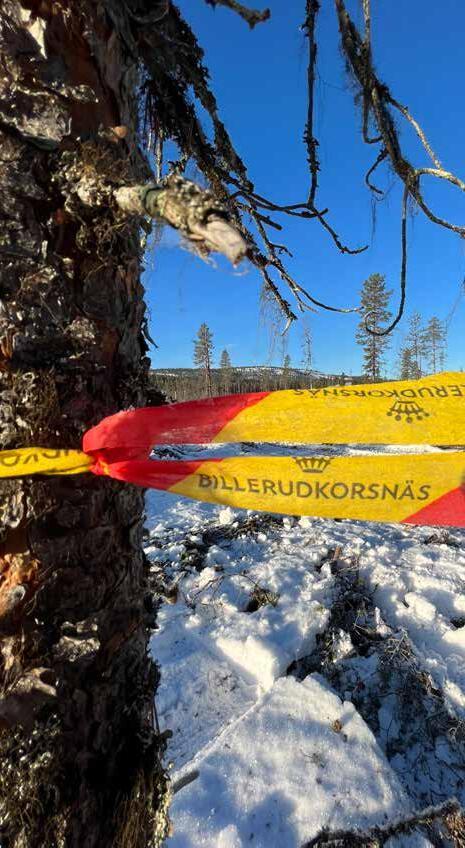
This approach does not offer a reliable guarantee of protection. For one, the small forest owners (who own half of Swedish forests) often do not have the competence, or the resources to bring in competence, to do a proper inventory of the biodiversity values of their forest. At the same time, there is no real incentive to discover or report any such values. A study by the Environmental Protection Agency found “Forest owners have weak incentives to invest in measures that increase biodiversity on the property as the value of forest as an investment decreases if the forest contains high natural values.” 51 Or, as one forest owner pointed out in a letter to the editor:
Reporting red-listed species to the Species Information Center is for a forest owner like advertising in the subway that you have a lot of money in the mattress at home and the door is unlocked. Such self-harming behaviour cannot be seriously requested or believed to be engaged in by a forest owner. You don’t want to have to abandon your farm and home or to have your dreams crushed by deliberately impoverishing yourself by preventing logging on your own land, do you?!52
No improvement in sight?
The current government in Sweden is attempting to further weaken the already dysfunctional oversight system. In February 2024 the Swedish government appointed a commission to propose changes to the current regulatory framework. The directive to the investigating commission, entitled “A robust forest policy that sees the forest as a resource” 53 is considering the elimination of the logging notification system altogether or weakening it considerably, taking away the one tool that enables detailed oversight by the Forest Authority and the public. The directive instructs the committee, among other things: “To consider whether it is appropriate to replace the current supervision regime, based on a logging notification, with another supervisory system, such as a system based on self-monitoring.” The investigation further aims to limit the legal recourse that the public has for appealing the authorities actions (or inactions) for forest protection.
It remains to be seen whether the investigation commission’s recommendations will lead to a weakening of an already weak system. However the signal that the directive to the commission sends is that no improvement can be expected soon.
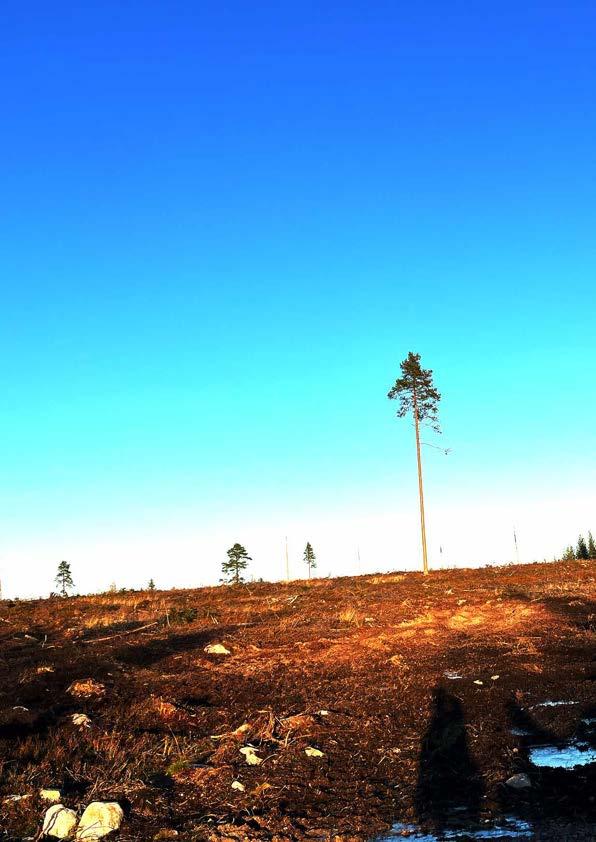

12 KILLED BY CARDBOARD • NATURE CRIME FILES – DECLASSIFIED, SWEDEN
© Greenpeace © Greenpeace
FAILURE OF CERTIFICATION
Many consumers do not solely want to rely on governments to prevent destructive forestry. Instead, they look to certification institutions for guarantees that products do not harm nature.
However, there are major systemic problems with these schemes such as the Forest Stewardship Council (FSC) and the Programme for the Endorsement of Forest Certification (PEFC).54 The Swedish FSC system, which is seen as the more robust of the two schemes, has been plagued by its inability to guarantee that the companies that carry the certificates do not log or market timber from old-growth forests.55 Similarly the Swedish FSC standards expressly allow clear-cutting as the logging method.56
This can be confusing for consumers, since FSC national criteria and standards can vary significantly from country to country. In Germany, for example, FSC labelled wood only comes from clear-cuts as an exception. Thus a German consumer may not be aware of the fact that a product with an FSC stamp may come from a forest that is logged in accordance with significantly different rules than they would expect.
FSC and Biodiversity
In 2023, FSC International commissioned an audit of the Swedish national FSC system.57 The study focused on the central feature of FSC methodology for identifying forests with high conservation value – Woodland Key Habitats (WKH). These are defined as “habitats (nature types) that are especially valuable from the nature conservation point of view, and where endangered, vulnerable, rare or care-demanding species can be expected to occur.”
58
The concept of WKH is central to the Swedish FSC definition of areas that must be “Exempt from all management activities other than management required to maintain or promote natural biodiversity or biodiversity conditioned by traditional land use practices.”59

The study found that the Swedish FSC standards are too vague in specifying how identification of WKH must be conducted by the certificate holders. The rules allow the certificate holders to ignore the presence of red-listed species in the forests they intend to log and sell as FSC controlled wood. It summarises some of the findings as follows:
For forest management certificate holders, the NFSS (National Forest Stewardship Standard) requirements for ensuring robust assessments and conservation of WKH are ambiguous and open to different interpretations regarding the preharvest natural value assessment methodology to be applied. Thus, certificate holders have room to apply less stringent methodologies for the identification of WKH.
Until 2021, the identification of Woodland Key Habitats in privately owned forests was carried out by the Forest Agency. Although this did not directly lead to any form of formal protection, it served as a useful tool for the certification process under FSC or PEFC. However, in response to lobbying pressure by the industry, the Agency ceased to do so by the end of 2021, and allowed for the de-registration of WKH mapped after June 2019, if requested by impacted forest owners.60
The decision to stop the Agency’s registration of WKH yet again demonstrated the failure of governance systems, and at the same time made the FSC and PEFC certification schemes significantly weaker, since a central parameter for identification of forests with high natural values was no longer available.
The designation of a forest as a WKH did not guarantee protection even when these were being registered. Between 2000 and 2018, 55,000 hectares of key biotypes were logged, for example.61 Even so, the loss of official identification and registration
of these critical areas makes certification even more toothless, and is greenwashing destruction of nature. With authorities no longer identifying WKH, you might expect certifying bodies to demand operators obtain this information by other means. This is not the case.
This is exacerbated by a significant decrease in compensation for forest owners setting aside forests with high nature value. There is no financial incentive for protecting biologically valuable areas, but timber from these areas can be sold into FSC certified supply chains, generating profits for the forest owner.
The internal investigation conducted for FSC International by the auditing agency Accreditation Services International (ASI) summarised this by stating that the large surge of complaints about FSC infringements in Sweden “Is partially driven by external factors, such as the cessation of WKH delineation by the widely trusted Swedish Forest Agency (SFA) on private forest lands and reductions in funding by the current Swedish government to compensate forest landowners for conservation set-asides.”
62
These external factors are not the only reason for the fact that FSC labelled timber from Sweden often comes from forests with high conservation values. Another central element contributing to this is the failure of the certification bodies to carry out their core role – verifying that the FSC standards are adhered to. This is evident from the fact that the vast majority of complaints of non-compliance with FSC standards only arise when the problem is noticed by an external actor. As the FSC internal review puts it: “A conclusion of the ASI personnel with access to complaints/incidents was that almost all the described non-compliance cases recorded by ASI were discovered and made public by environmental stakeholders. The need to verify these findings by means of special in-depth certification and accreditation assessments calls into question the effectiveness of the routine work of certification bodies and the sufficiency of the current versions of the FSC normative requirements.”
Trust in the objectivity of certifying bodies, and thus in the whole system, is further eroded by the close relationship between certifiers and logging operators. Certifying companies are retained and paid by the logging operators, creating a direct financial conflict of interest; they are also at times involved in the industrial activity themselves.
The example below illustrates the inadequacy of FSC certification:
Solberga forest, in the county of Dalarna, is a calcareous spruce continuity forest notified for logging. This is a particularly sensitive type of habitat. Skogsstyrelsen writes: “Calcareus coniferous forests make up some of our most endangered, rare and at the same time species-rich habitat types…Their protection and management are of great importance for the overall objective of preserving forest biodiversity... Many of the threatened species that are adversely affected by logging are dependent on long forest continuity.” 63
A number of inventory efforts by voluntary forest biologists have reported56 occurrences of red-listed species in the notified area. The environmental NGOs, whose members conducted the field inventories, informed the owners and the Forest Agency of their findings. The Forest Agency did not issue an order prohibiting logging in the area, instead allowing for logging most of it, with some adjustments. After the NGOs filed a legal complaint, the court upheld that the authority acted within its mandate.64
The preponderance of red-listed species spread throughout the area, as well as the structure of the forest (many old trees, high variation of ages and species of trees, large volume of dead wood) are clear indicators of the area as a WKH. Since the Forest Agency no longer carries out identification and mapping of WKH, the forest was not included in the official list.
Despite the clear indication of high conservation values, the forest received FSC certification, was logged by and sold to an FSC certified company. The certification process failed to protect biological values in this case, because:
• The forest was audited under FSC guidelines by Prosilva – a company that acts as a so-called group leader for an FSC group certificate, applying to all its group members (2,967 in the case of Prosilva).65 Prosilva audits rely on a group of agents, which consists of a number of larger forest companies, sawmills and pulp mill operators. These agents are also amongst the owners of Prosilva.66
• The logging was carried out by the FSC certified67 sawmill operator Fiskarheden Trävaru AB.68
• Fiskarheden is listed as one of the owners, as well as agents of Prosilva.
• In addition to carrying out the logging, Fiskarheden had a contract for the purchase of the logged timber, and intended to use it in their production.69
14 15 KILLED BY CARDBOARD • NATURE CRIME FILES – DECLASSIFIED, SWEDEN KILLED BY CARDBOARD • NATURE CRIME FILES– DECLASSIFIED, SWEDEN
In summary, an FSC certified sawmill co-owns a company offering FSC group certification. This company provides group certification to a forest owner, upon an audit done by one of its other co-owners. The sawmill then makes a contract to log this forest and buys the timber. Since the forest owner is certified, the company gets FSC certified timber. The product can now be sold as FSC certified, despite the fact that it comes from a forest with the characteristics of a WKH with documented very high natural value that should not have been logged under FSC criteria.70
This case highlights the fundamental flaws in the FSC’s group certification scheme, which leaves all responsibility for the audits of the actual forest areas to private business operators, without any real third party control. The certification body granting this FSC group certification, SCS Global Services, had visited less than 1% of all the forest areas certified under Prosilva’s group certificate.71
A complaint has been filed with FSC, but the forest is gone, and the product is on the market deceiving customers that strive to buy sustainable products.
When confronted with these facts in advance of publishing this report, both Prosilva and Fiskarheden stated that the FSC certification was based on the decision of authorities to allow the logging, as well as the consequent court ruling. This explanation illustrates that despite authorities’ failure to protect forests with high natural values, FSC certifiers of Swedish do not strive to go beyond the legal requirements.
FSC and Indigenous Rights
An important element of FSC certification is respect for Indigenous Peoples and their livelihood. According to the FSC, an FSC-certified company “...shall recognise and uphold the legal and customary rights of indigenous people.” This includes the principle of free, prior and informed consent (FPIC).72 In Sweden, FPIC is implemented through a participatory planning process.
Many forest management activities can have a negative impact on reindeer grazing lands, as is acknowledged in the FSC standard.
In Sweden, FSC certified companies must ensure that the Sámi’s livelihood, culture and tradition is not threatened by the forest management. The FSC requires that reindeer herding communities (RHC) are offered
a participatory planning process with the aim that the RHCs should have an influence on the forest management measures carried out on their land. Therefore, the RHCs have to give their consent to management activities such as clear-cuts, fertilisation or road construction. If there is a disagreement whether the management activity affects reindeer herding or not, there is a process for conflict resolution.
So on paper, it seems like Indigenous rights are well integrated in the FSC process and thus respected. In reality, there is an imbalance in power and it is mostly the forestry sector who successfully impose their interests upon the reindeer herders. Even when the RHC voices concerns regarding specific management practices, its opinion is often discounted and a logging operation is conducted as planned. A typical example of such a process is described by Sámi participants in such FSC-based consultations:
The parties are not equal. Sveaskog always has the upper hand and does not hesitate to use its position of power to pressure the other party into concessions. The goal is to access the forests in the reindeer herding country. Sveaskog does not listen to the Sami. Sveaskog has no respect for the Sami’s activities. In addition, knowledge of the conditions of reindeer husbandry is non-existent among the company’s representatives.
Here is an example of Sveaskog’s tactics. Before each consultation, the company has made a list of forests that it wants to cut down within the village’s reindeer pastures. There are often more than 20 forests on the list. The vegetation description is minimal. Not a word that it could be about lichen forests, vital during reindeer’s winter grazing. The column regarding considerations for reindeer husbandry is empty.
Sveaskog addresses every forest on the list. ‘If we are not allowed to take this forest, we must be allowed to take that one’ and so on. It is coldly assumed that the Sami villages will not be able to resist and say no to everything, they will finally agree to a large number of fellings. So it goes on, consultation after consultation.
The Sami village’s refusal to cut down a forest is not respected. It only applies to the consultation in question. At the next meeting, Sveaskog can take up the same forest again. This continues until the company gets what it wants! 73
This is possible in part because the current FSC guidelines are designed so that logging companies will always have the final decision in cases of a disagreement. The conflict resolution procedure presented in the FSC National Standard of Sweden describes a number of time-consuming steps that can be taken in case the RHC does not agree to the proposed logging. If no agreement is reached as a result of these steps however, the company may log despite opposition of the Sámi. It is described as follows:
If the parties still cannot reach an agreement after mediation and after the dispute resolution committee has assessed that all possible adaptations from both parties have been considered in the participatory planning process, i.e. the representatives of the Sami village withhold their consent and the forest owner still intends to carry out the planned activity, it is up to The Organization to either:

a) raise the management activity for participatory planning again once the forest grazing conditions have changed, or;
b) carry out the activity without the consent of the Sami village. 74
Mainly, an FSC certificate holder only changes its approach if it is issued a deviation by the auditor. For this to be possible, the RHC needs to have detailed working knowledge of the FSC standard. The majority of the RHCs do not have the time or sufficient knowledge to make a complaint to an auditor. The RHCs therefore have little capacity to follow the formal procedures necessary for filing a complaint. They work with reindeer herding, not forestry regulation or bureaucratic processes that the complaint system prescribes. This imbalance of power and resources makes the FSC complaint system ineffective, allowing certificate holders to continue operating on Sámi lands disregarding opposition from the RHCs.
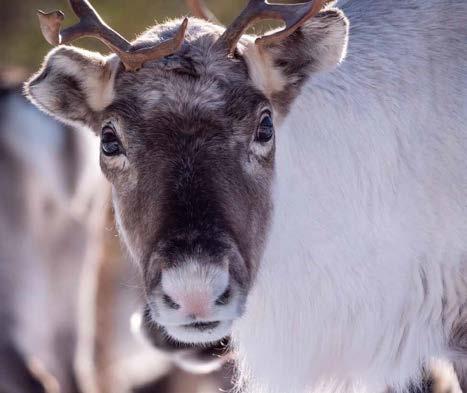
16 17 KILLED BY CARDBOARD • NATURE CRIME FILES – DECLASSIFIED, SWEDEN KILLED BY CARDBOARD • NATURE CRIME FILES– DECLASSIFIED, SWEDEN
© Rasmus Törnqvist / Greenpeace

THE ROLE OF THE PULP INDUSTRY
Our research, detailed later in this report, linked most major producers of paper and paperboard in Sweden to clear-cuts in forests of high natural value
As the timber from these areas enters the production lines without separation, any European paper producer or converter or final customer buying from Sweden runs a high risk of being linked to the destruction of the last unprotected natural forests in Sweden. The forestry model applied in Sweden is optimised for providing resources and profits for the pulp and paper industry to the detriment of the environment, the climate and indigenous livelihoods. The focus of forestry operation is primarily on producing biomass for the pulp and paper mills, rather than for high-value sawn wood and construction materials. Some two thirds of the timber harvested in Sweden is consumed by the pulp and paper industry.75
With an annual production of 12 million tonnes of pulp,76 Sweden is Europe’s largest pulp producer, accounting for a third of all pulp produced in the region.77 In total, over 80% of Sweden’s production of pulp, paper and sawn timber is exported, making Sweden the 4th largest exporter of wood products in the world.78
Europe is the main destination for these exports, receiving 41% of the exported sawn timber, 57% of all pulp and 67% of all paper products. Germany alone takes a fifth of all Swedish paper exports.79 Outside Europe, China and the US are buying substantial amounts of paper products from Sweden, but also many other countries (see Figure 5).
In recent years Swedish forests produced more than 90 million cubic metres of wood biomass per year, equivalent to ten Eiffel towers. This volume came from clear-cutting 250,000 ha, an area bigger than Lon-

don and Berlin combined, and from thinning operations on another 290,000 ha.80
With a massive decline globally in the demand for printing papers since well over a decade, pulp use shifted to the manufacturing of packaging paper and paperboard, accounting for two thirds of all paper production, in 2022, both globally and in Sweden.81 Printing papers account for less than a fifth, with the rest going into tissue papers, newsprint and other end-uses (see Figure 3). Driving this shift are an ever growing e-commerce sector and a trend away from plastic packaging towards so called renewable paper solutions.82
SCA, a major paper producer and Europe’s largest private forest owner, has fully shifted its paper division
19 KILLED BY CARDBOARD • NATURE CRIME FILES– DECLASSIFIED, SWEDEN
100 0 1961 2022 2000 1980 PACKAGING PRINTING, WRITING TISSUE OTHERS NEWSPRINT The decline in paper production for printing is negated by a massive increase in demand for packaging paper and paperboard. Source: FAOStat 88 © Greenpeace
Figure 2. Global trends in paper production 1961–2022, million tonnes per year.
200
to the production of packaging papers, providing nearly a fifth of all kraftliner consumed in Europe.83 Its direct competitor, Stora Enso, dissolved its printing paper division in 2023 to direct all its focus on the packaging sector.84
A major paper grade in the packaging sector is uncoated kraftliner, often used for the outer layers of the classic brown corrugated cardboard boxes or in solid paperboard for consumer goods packaging. According to SCA, the demand for kraftliner is expected to increase by about 2% per year in the long-term.85 The kraftliner from Sweden is highly sought after for its strength from the strong fibre from the country’s slow growing trees. Sweden produces more than three quarters of Europe’s entire sold production of uncoated kraftliner.86 Nearly all of it is exported, again largely to Europe.87
Figure 4. Uncoated kraftliner production in the EU 2022, percentage based on volume.
Figure 5. Sweden's paper exports 2022, percentage based on volume.
Packaging paper & paperboard is now the leading use of pulp produced from wood fibre. Source: FAOStat 89
Europe accounts for two thirds of Sweden’s exports of paper and paperboard. Source: Eurostat 91
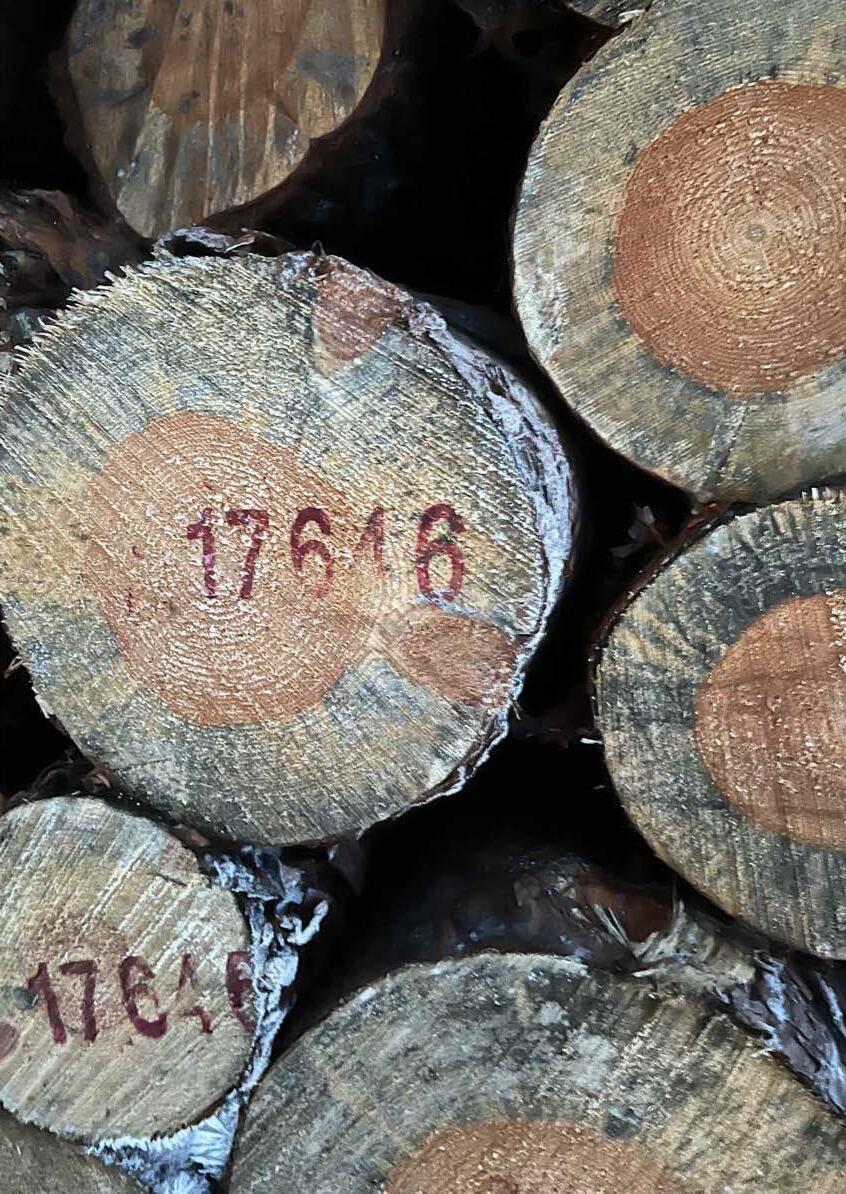

20 KILLED BY CARDBOARD • NATURE CRIME FILES – DECLASSIFIED, SWEDEN
77% PORTUGAL: 17% ITALY: 4% FINLAND: 2%
SWEDEN:
Sweden produces more than three quarters of Europe’s entire sold production of uncoated kraftliner (2022, by volume. Source: Eurostat 90
PACKAGING: 64% TISSUE: 9% NEWSPRINT: 3% PRINTING & WRITING: 19% OTHERS: 5%
Figure 3. Global paper production by paper type 2022, percentage based on volume.
GERMANY: 20% ITALY: 7% NETHERLANDS: 5% DENMARK: 4% POLAND: 4% FRANCE: 4% BELGIUM: 3% OTHERS EUROPE: 12% USA: 5% CHINA: 4% OTHERS: 25% UK: 7%
© Greenpeace
GREENPEACE FINDINGS
This section presents an overview of the investigation Greenpeace conducted during 2023 and 2024, establishing links between logged continuity forests in Sweden and companies selling brand-named products around the world.
The links in the chain also include pulp mill operators in Sweden as well as processor companies both in Sweden and in other parts of the world that receive material from Sweden.
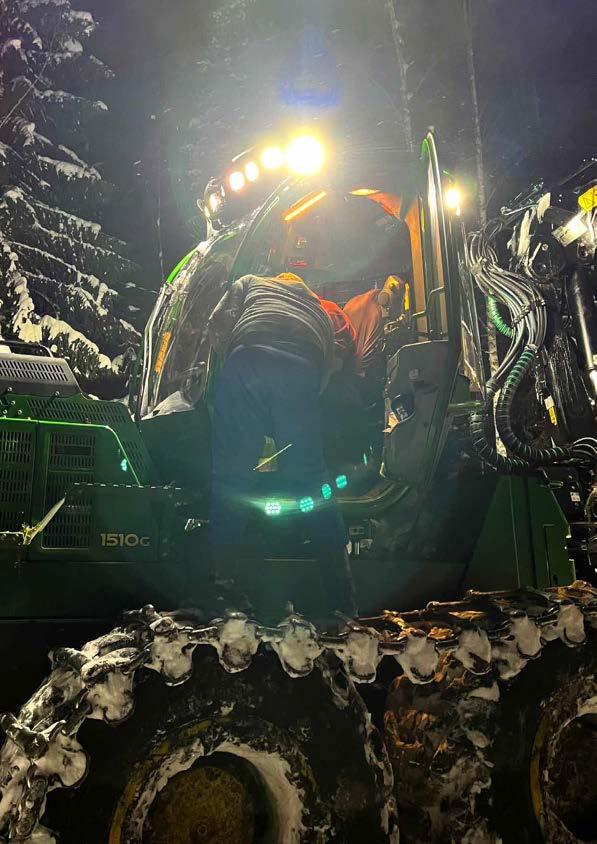

22 KILLED BY CARDBOARD • NATURE CRIME FILES – DECLASSIFIED, SWEDEN
© Greenpeace
We present a summary outline of the findings of the investigation and the methods used to obtain them. The detailed results and a comprehensive listing of each of the established links in the chain of custody are presented in the appendix.
Step one: Forests to Mills
This segment of the investigation aims to establish and document the flow of material from clear-cuts in oldgrowth forests to processing facilities, such as pulp mills and sawmills. The investigation was carried out through a number of steps:
• Defining and identifying old-growth forests.
• Identifying recently logged areas.
• Carrying out tracking investigation in the field (a total of six week-long field trips to 68 logging sites, covering six counties, over the period of August to December 2023).
• Follow-up communication to some of the parties identified in the investigation (loggers and pulp mills).
Defining old-growth areas to be investigated
The first step in designing the investigative method was to decide which forests to monitor. The investigation focused on clear-cuts carried out in the so-called continuity forests. Fundamentally, these are forests that have never been clear-cut, and as a result can be expected to have high natural values. The more expanded definition provided in the documentation of the mapping of continuity forests by Sweden’s Environmental Protection Agency (EPA) and Forest Agency is as follows:92
“Forests containing natural value species whose occurrence is explained by the long-term existence of suitable forest environments and substrates in this particular forest or in its vicinity… The major dividing line in the occurrence of natural values is between forests that have been cleared and not cleared.”
The original map layers had various degrees of uncertainty, which were gradually decreased by subsequent more precise analysis.93
The EPA has made a rough estimate of the area of primary and old-growth forest (ur- och naturskog).94 This was done using different forms of data, including remote sensing, identifying ”probable continuity forests” and ”potential continuity forests”. The report ex-
plains the result of the mapping as follows: ”Probable continuity forests have no traces of late forestry and all areas have been checked in aerial photographs. Potential continuity forests have been evaluated statistically but the areas have not been controlled.” The report continues: “The probable continuity forests are dominated by older forest, the majority are over 120 years old and a quarter are over 160 years old.”
The authorities’ mapping of continuity forests was not just a theoretical exercise. The forests identified by this methodology are seen as the basis for pinpointing forest areas that need to be protected. The final report of the 2017 mapping of continuity forests in the boreal region produced for the EPA states “the mapping of continuity forest provides a useful basis for finding valuable forests in need of formal protection” 95
Definition criteria for continuity forests are quite close to those of “old-growth forests” as defined by the EU as a forest category that needs to be protected:
“A forest stand or area consisting of native tree species that have developed, predominantly through natural processes, structures and dynamics normally associated with late-seral development phases in primary or undisturbed forests of the same type. Signs of former human activities may be visible, but they are gradually disappearing or too limited to significantly disturb natural processes.” 96
All of the forests we examined were in the category of probable continuity forests, with one exception where the old-growth values were established by an independent inventory carried out by volunteer field biologists.
Throughout this report, we use the more colloquial term old-growth forest synonymously with the more technical term continuity forest. Additional mapping information about the areas we investigated included:
• Natura 2000 maps.
• Maps of known Woodland Key Habitats.
• Maps of high value forest landscapes (värdetrakter).
• Maps of EU Habitat and Bird Directive sites.
• Maps of Forest Agency’s Objects with Natural Values.
• Inventories conducted by public organisation experts.
• Registered findings of red-listed species.
Summary of documented links
The investigation was successful in establishing and documenting connections from 19 logged old-growth forests to 9 pulp- and paper mills and 4 sawmills.
Table 1: Pulp- and paper mills in Sweden documented to receive wood from clear-cuts in Swedish old-growth forests in late 2023.
Company (Headquartered in)
Ahlstrom Sweden AB (Sweden)
Billerud Sweden AB (Sweden)
Holmen AB (Sweden)
Holmen AB (Sweden)
Metsä Board Oyj (Finland)

SCA (Svenska Cellulosa AB, Sweden)
SCA (Svenska Cellulosa AB, Sweden)
Stora Enso Oyj (Finland)
Smurfit Kappa (Ireland)
Mill Company description Main products
Billingsfors Ahlstrom is a globally operating company focusing on fibre-based specialty materials.
Karlsborg Billerud is a globally operating company, producing carton & containerboard, liquid packaging board, kraft & sack paper, graphic paper and market pulp.
Iggesund Holmen is one of the largest forest owners, and operates several saw mills and pulp & paper mills in Sweden and the UK, producing saw timber, newsprint, book paper and other graphic papers.
At Billingsfors, the company produces market pulp and coated speciality papers. 97
At Karlsborg the company produces kraft & sack papers, formable paper (FibreForm®) and market pulp.
At Iggesund, the company produces pulp, and high-quality cartonboard. 98
Hallsta See above. At Hallsta, the company produces pulp, light- weight uncoated, book and office papers. 99
Husum Metsä Board, part of the Finnish Metsä Group, operates pulp & paper mills in Sweden and Finland, with a focus on lightweight and high-quality folding boxboards, food service boards and white kraftliners
Munksund SCA claims to be Europe’s largest private forest owner. The company offers amongst others packaging paper, pulp, wood products, renewable energy and services for forest owners. 100
At Husum, the company produces bleached chemical pulp, folding boxboard and uncoated white kraftliner.
At Munksund, the company produces, kraft pulp and white or brown kraftliner for consumer and transport packaging, " largely based on fresh wood fibre ". 101
Obbola See above. At Obbola, the company produces kraft pulp and kraftliner for consumer and transport packaging, " largely based on fresh wood fibre " 102
Skoghall Stora Enso is a globally operating company, producing sawn timber, market pulp, printing papers, packaging papers & products, and other wood fibre based products
Piteå Smurfit Kappa is a globally operating, vertically integrated pulp, paper & packaging producer.
At Skoghall, the company produces pulp and packaging boards for consumer products, dry food and liquid packaging containers. 103
At Piteå, the company produces pulp and white & brown kraftliner, mainly for further processing at their packaging plants across Europe. 104
In addition to the pulp mills listed above, we were also able to track wood from clear-cutting continuity forests to the following sawmills: Fiskarheden Trävaru AB, Trandstrand sawmill; Ljungträ AB, Munktorp sawmill; SCA Timber AB, Munksund sawmill; Stora Enso AB, Gruvön sawmill. Details of the investigation’s findings are presented in Appendix.
24 25 KILLED BY CARDBOARD • NATURE CRIME FILES – DECLASSIFIED, SWEDEN KILLED BY CARDBOARD • NATURE CRIME FILES– DECLASSIFIED, SWEDEN

Step two: Mills to Markets
The Swedish pulp- and paper industry supplies customers in a wide variety of market sectors discussed in more detail below. For nearly a year we investigated supply chains from Sweden to these markets. In our investigations, we focused mainly on customer companies in the ever booming e-commerce sector.
• Much of this information was available via public internet sources, company webpages, publications etc.
• We also relied on our extensive network of volunteers to physically check products used by online traders, or found at supermarkets, for information that identified the packaging producer.
• In some cases, we had to resort to covert approaches, to secure reliable information, in particular when it came to documenting where European paper converters source from in Sweden.
We identified hundreds of companies that had recent105 customer relationships – either directly or indirectly (via 3rd party paper converters) – to companies running pulp and paper mills in Sweden, linked to the destruction of old-growth forests.
It must be understood that our research does not prove the presence of Swedish old-growth fibre in any particular product. Rather it is a proof that, due to their procurement links, all of these customers are exposed to the risk of selling their products in packaging made from fibre originating from forest destruction in Sweden.
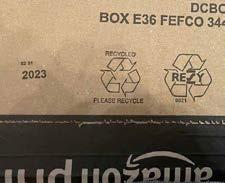
The e-commerce packaging sector
Smurfit Kappa brought its e-commerce offering under their so-called e-smart umbrella in 2017 - then claiming to work with 70% of Europe’s ”leading e-retail brands” Amongst those were Zalando, CDdiscount and HelloFresh. According to the company this placed “Smurfit Kappa firmly at the forefront of e-commerce packaging solutions.”106 We also found Smurfit Kappa to be linked to the production of Ebay branded boxes,107 and acting as one of the suppliers of Amazon shipping boxes.
SCA (Svenska Cellulosa Aktiebolaget) runs two large kraftliner mills in Munksund and Obbola. Our research confirmed SCA supplying kraftliner to pan-European packaging producers Schumacher Packaging (Germany) and DS Smith (UK).108 Both companies are major suppliers of packaging products to Amazon, according to our investigations.109
DS Smith supplies Zalando – the well established online fashion retailer, based in Germany and operating across Europe, claiming to be a major supplier to the company.110 Zalando also sources from Stora Enso.111
Meal delivery packaging
A more recent addition to the online retailer space are meal delivery services or recipe boxes, shipping fresh produce in refrigerated boxes to their customers, sometimes exactly portioned for a specific recipe. The dominant player in this market is HelloFresh, headquartered in Germany and operating across Europe, Australia and New Zealand. Its largest market, though, is North America where it held 78% of the US market share in 2022.112 Smurfit Kappa claims to have
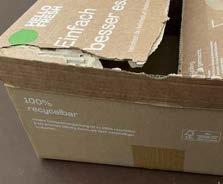
developed their new shipping box,113 while Greenpeace Nordic research confirmed SmurfitKappa to supply HelloFresh in Germany as of early 2024.114
DS Smith is another supplier of HelloFresh boxes, although, at least partially, supplying boxes made entirely from recycled fibre.
Similar companies like Mindful Chef, a Nestlé subsidiary115 in the UK, and Crisp, an online supermarket operating in the Netherlands and Belgium, are also amongst Smurfit Kappa’s clients, according to the company itself.116
Fast-moving consumer goods
Kraftliner is not only used in corrugated shipping boxes, but also in so called cartonboard, used to package food and household items bought on a regular, if not daily basis. Smurfit Kappa provides such packaging to German discounter Netto117 and Aldi Nord118 for their own brands. Amongst its clients we also found detergents giant Henkel, German DIY OBI,119 the Italian edible oil producer Bertolli, dairy company Granarolo, coffee suppliers Lavazza and Segafredo, dairy company Arla from Denmark, PepsiCo120 and Coca-Cola,121 as well as the food giants Nestlé,122 Unilever123 and Mars.124
SCA kraftliner customer Schumacher Packaging lists Lorenz Bahlsen,125 and Henkel126 amongst their customers, while Procter & Gamble lists them as one of their suppliers.127
Slow-moving consumer goods
Producers of slow-moving consumer goods are also linked to Swedish forestry through their suppliers, with Smurfit Kappa supplying electronics producers Sam-
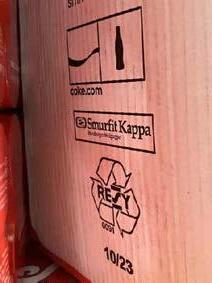
Liquid packaging
With Stora Enso and Billerud, Sweden is home to two of the world’s largest producers131 of liquid packaging board. This product is turned into the containers we see in supermarkets, by a few global players, in Europe mainly Tetra Pak, Elopak and Sig Combibloc –all three customers of Stora Enso.132 Billerud and Stora Enso supply 98% of the liquid packaging board used by these 3 companies for their European production, according to the lobby organisation representing the five companies at EU institutions.133
Main Market Sectors and Directions of Change
Given the fact that the packaging industry is the largest and fastest growing user of the wood fibre from Swedish forests, it has a key role in pushing for sustainable solutions. These solutions will have to look different for the different parts of the packaging industry. Some of these are well positioned to ensure that virgin fibre is constantly brought into the recycling stream. As fibres break down in the recycling process, a small share of virgin fibre is needed to maintain needed paper qualities. Most types of cardboard products are easy to collect and recycle – fresh fibre used here is not lost rapidly from the system. Still, the sheer amount of packing consumed already cannot not be


26 27 KILLED BY CARDBOARD • NATURE CRIME FILES – DECLASSIFIED, SWEDEN KILLED BY CARDBOARD • NATURE CRIME FILES– DECLASSIFIED, SWEDEN
Amazon box from late 2023, showing Smurfit Kappa's RESY certification code 0021. © Greenpeace
HelloFresh shipping box, bearing Smurfit Kappa's FSC code. Hamburg, March 2024. © Greenpeace
Box for a Samsung TV, supplied by Smurfit Kappa, Dec 2023, Greenpeace
Left: Coca-Cola cardboard shelf trays supplied by Smurfit Kappa, Germany, Feb 2024. Right: Smurfit Kappa had been awarded PepsiCo’s supplier of the year in 2023. © Greenpeace
sustained by sustainable forestry practices. Hence, a reduction in consumption will also be needed here. Within the packaging sector, it is the e-commerce sector that is driving demand for forest fibre. Online traders like Amazon, Zalando and HelloFresh need to use their influence to ensure their suppliers do not overexploit forests or source from forests with high natural values. They also need to be at the forefront of adopting reusable shipping solutions.
The same is true for the companies switching their packaging materials from plastic bags, trays and wrappings to paper-based ones. Arla Sweden, recently announced that they will change the packaging for a part of their product range from plastic to plastic coated paper.134
This is meant to reduce the overall amount of plastic used in the company’s packaging. However, according to conservative industry estimates, the world consumes a staggering 352 million tonnes135 of plastic a year. The global pulp production of 197 million tonnes136 offers no capacity to absorb any of this huge plastics market. This shift from plastic to paper sounds positive but it is simply shifting the problem elsewhere, increasing the pressure on forest ecosystems.

Long-established markets for paper-based packaging bear their responsibility, too. In particular those whose paper products are designed for single-use and are difficult to recycle. This refers to products such as cups and food boxes at McDonalds, BurgerKing, KFC and others, or those selling liquids in Tetra Pak-style containers.
Finally, companies selling fast moving consumer goods – everyday supermarket items from bread to toothpaste – have to act, too, given the large volume of paper and paperboard being used for the packaging of their products.
All of these sectors need to fundamentally rethink how they get their products to their customers, adopting approaches that reduce the need for single use packaging drastically.

Figure 6. Supply chain connections established between clearcutting of old-growth forests in Sweden and cardboard packaging

OLD-GROWTH FORESTS OF SWEDEN
28 29 KILLED BY CARDBOARD • NATURE CRIME FILES – DECLASSIFIED, SWEDEN KILLED BY CARDBOARD • NATURE CRIME FILES– DECLASSIFIED, SWEDEN
HOLMEN SCA SMURFIT KAPPA STORA ENSO METSÄ BOARD
Paper cup warning of plastic in what is commonly sold as a paper cup. © Greenpeace
BILLERUD MINDFULL CHEF (NESTLÉ) HELLO FRESH CRISP SAMSUNG ELECTRONIC PHILIPS UNILEVER PROCTER & GAMBLE NESTLÉ COCA-COLA MARS PEPSICO HENKEL NETTO ALDI NORD LIDL TETRA PAK SIG COMBIBLOC ELOPAK SCHUMACHER PACKAGING LIQUID PACKAGING RETAILERS ONLINE FOOD BOXES ONLINE TRADERS ELECTRONICS CONSUMER GOODS EBAY ZALANDO AMAZON DS SMITH © Greenpeace
:CONCLUSION RESPONSIBILITY LIES WITH THE MARKETS
Swedish forestry as it is carried out today is a threat for biodiversity, climate and Indigenous rights. Neither the existing regulatory measures nor voluntary certification schemes have succeeded in eliminating this threat. The responsibility lies with the markets.

The problems with Swedish governance and certificaton do not mean that it is impossible to conduct forest management in a non-destructive way. A joint appeal by a large group of scientists, NGOs and Sámi organisations outlines a vision of how this can be done 137 But where is the impetus to make this vision a reality?
It is ultimately the customer of a commodity that holds the key to how products are made. If a company strives to minimise the negative effect of its business on the environment, if corporate responsibility is a meaningful aspect of its operations, if it promises to its clients that the product they are purchasing is sustainable, then it must ensure that its purchasing is not contributing to the destruction of forests with high natural value in Sweden, nor to forestry practices that threaten Sámi reindeer husbandry, and lead to negative effects on climate, water and biological diversity.
Given the failure of Swedish governance and voluntary certification to provide protection of natural values in forests, customer companies who directly or indirectly source products made from fresh wood fibre from Sweden run the risk that their products are manufactured with material originating from old-growth forests.
Greenpeace expects that environmentally responsible corporate customers of Swedish forest products, regardless of whether they are named in this report, will take concrete steps to ensure that the resource flow into their product does not come from forests with high natural values.
More specifically, any such companies should take the following steps:
Step 1. Eliminate material that originates from clear-cutting old-growth forests
The first, most urgent (and most simple) step that a responsible customer of Swedish forest products can take, is to demand that their suppliers only provide them with material that originates from outside of the remaining continuity forests.
The maps of these areas are freely available from Swedish government geodata sites. An excellent compilation of these resources can be accessed through an interactive map, setup by the Swedish NGO Skydda Skogen.138 This service provides maps of Swedish forests with confirmed and probable high conservation values, as well as areas with potential and probable continuity forests. The resource also provides maps of other forests with indications of high conservation values.
The companies sourcing material from Sweden should request from their suppliers that they guarantee that the material they provide does not originate in the areas identified in these maps as continuity forests, or as other forests with identified high natural value.
Step 2. Work towards better regulation
It is pivotal that a reliable regulatory protection of forests is firmly in place. The responsible companies-consumers of forest products should support and promote the implementation and adoption of rules and policies in Sweden and at EU level which set out a truly sustainable model, in line with international commitments on climate and biodiversity and internationally recognised human rights, that protects and restores nature and ends destructive forestry practices.
In particular, corporate players in Europe should promote and support the implementation of the Kunming-Montreal Global Biodiversity Framework Agreement and the EU biodiversity strategy for 2030.
Both commitments demand from signatories and member states of the European Union the effective protection of at least 30% of land and water areas by 2030. Countries are asked now before the next UN Conference of the Convention of Biological Diversity in Colombia to present plans for which ecosystems they intend to effectively protect in the future in national biodiversity strategies and action plans.
Greenpeace demands governments to immediately protect especially high biodiversity value areas,
including old-growth forest ecosystems, to exclude harmful activities from protected areas that are counted towards the 30% target, and to restore degraded lands and forests elsewhere. Sweden, with its flawed and destructive forestry model, has a lot of homework to do.
A detailed set of political demands by Greenpeace to effectively protect forests can be found on our website.139 Additional Sweden-specific demands are presented in the joint NGO-scientist appeal 140
Step 3. Reducing pressure on forests – shifting from single use to reuse or
recycled
As well as shifting away from old growth forests, and working towards better regulation, it is also necessary to reduce the total amount of wood fibre we consume. The planet simply cannot handle the current overconsumption of disposable items.
There are several, complementary options to tackle this.
– Single use items in fast food and takeaways (cups, boxes, pouches, bags etc) can be recycled in principle. In practice, they frequently end up in mixed trash or even in nature.141 The sector must shift from single use items to reusable systems, which are already on the market in various countries.142
– Transport cardboard boxes are not the only solution for commercial shipping needs. There are numerous examples of reusable packaging solutions for online commerce, supermarket supplies, and many other sectors.143
– Toilet paper is an unnecessary end use for fresh fibre. Recycled fibre toilet paper should be the standard. Kitchen towels, napkins and handkerchiefs should at minimum be made from recycled paper as well, but preferably made from reusable and washable materials.
As the Swedish children’s story icon Pippi Longstocking says: “If you are strong, you have to be nice”. The markets have power, power to change for the better how we treat our forests. Swedish forests are an asset. An asset for nature, for climate and for the people who live in them. And a source of renewable material for a healthy life. They can remain an asset for us and for generations that come after – if they are used wisely. Let’s be wise and use our strength to preserve our forests.
30 31 KILLED BY CARDBOARD • NATURE CRIME FILES – DECLASSIFIED, SWEDEN KILLED BY CARDBOARD • NATURE CRIME FILES– DECLASSIFIED, SWEDEN
:
Endnotes

1 SLU (2020). Great conservation value of the Scandinavian Mountains Green Belt , Swedish University of Agricultural Sciences, Sep 29, 2020
2 SCB (2019). Markanvändningen Sverige 2015. Sjunde utgåvan , Statistics Sweden, Feb 20, 2019
3 Skogskunskap (2024) Vem äger skogen? , Skogskunskap, Mar 26, 2024
4 SCB (2022). 22 000 hektar ny formellt skyddad skogsmark , Statistics Sweden, Jun 30, 2022
5 Larsson, A. (2011). Tillståndet Skogen - rödlistade arter ett nordiskt perspektiv, Swedish University of Agricultural Sciences, 2011
6 Naturvårdsverket (2023). Levande skogar, Swedish Environmental Protection Agency, Dec 12, 2023
7 Sweden defines “continuity forests” as forests that have never been clear-cut, and thus maintain forest ecosystem continuity, which is seen as a precondition for species’ survival and thriving. The definition is congruent with the term “old-growth forest” These definitions are discussed in more detail later in the report , see Greenpeace Findings, Step one: Forests to mills
8 Larsson, A. (2011). Tillståndet Skogen – rödlistade arter ett nordiskt perspektiv, Swedish University of Agricultural Sciences, 2011
9 Ahlström, A., et al (2022). Widespread Unquantified Conversion of Old Boreal Forests to Plantations , in Advancing Earth and Space Sciences, Oct 28, 2022
10 Logging notifications are described in more detail later in this report, see Failure of Governance
11 Skogsstyrelsen (undated). Logging Notifications Data , Geodata portal of the Swedish Forest Agency, accessed throughout 2023 and 2024 YTD
12 Naturvårdsverket (2023). Continuity Forests data , Geodata portal of the Swedish Environmental Protection Agency (c), accessed Nov 2023
13 The relationship between the “continuity forest” as defined in the official maps and the definition of old-growth is discussed in more detail in subsequent sections of this report, see Greenpeace findings, Step one: Forests to mills
14 Naturvårdsverket (2022). Nettoinlagringen av koldioxid i växande träd minskar kraftigt , Swedish Environmental Protection Agency, Sep 29, 2022
15 SLU (2023). Skogsdata 2023 , Swedish University of Agricultural Sciences, 2023
16 DN (2022). Forskarnas varning: Skogen går från kolsänka till utsläppskälla , Dagens Nyheter, Oct 6, 2022
17 Björheden, R., (ed.) (2019). Climate Impact of Swedish Forestry, Skogforsk, 2019
18 See e.g. an open letter to the EU Council signed by 190 scientists. Accessible via: Euractiv (2017) Need for a scientific basis of EU climate policy on forests Open letter to the EU Council. Sep 25, 2017
19 Lindroth, A. (2021). Professor: Det går inte att trolla bort utsläppen från kalhyggen , Altinget, Oct 19, 2021
20 Lindroth, A. (2023). Clarifying the carbon balance recovery time after clear-cutting Glob Change Biol, 29: 41784179
21 Skogsindustrierna (undated). Klimat , Swedish Forest Industries, website, accessed Mar 2024
22 Skogsstyrelsen (2024). Avverkningsstatistik , Table 5 , Swedish Forest Agency, accessed Feb 24, 2026
23 Based on Intergovernmental Panel on Climate Change (IPCC) default values. See Greenpeace (2018). The impacts of industrial logging in the Great Northern Forest , Greenpeace International, Jun 2018
24 Truth Commission (undated). About the indigenous Sami ,Truth Commission for the Sami People
25 A Reindeer Herding Community, or a Reindeer Herding Village is defined as “a geographical area where reindeer herding is carried out … organised as an economic and administrative association” Source: Samediggi (2022) Kontaktuppgifter till Sveriges samebyar, The Sami Parliament, Sep 9, 2022
26 Berg, Anna (2010). Reindeer herding and modern forestry: the historical impacts on forests of two main land users in northern Sweden Published in Acta Universitatis Agriculturae Sueciae 2010, number: 2010:45
27 Sandström, P., et al (2016). On the decline of ground lichen forests in the Swedish boreal landscape: Implications for reindeer husbandry and sustainable forest management , Ambio, Volume 45, pages 415–429, Jan 11, 2016
28 Dettki, H. & Esseen, P.A. (1998). Epiphytic macrolichens in managed and natural forest landscapes: a comparison at two spatial scales. Ecography 21(6), 613-624
29 Aftonbladet, Opinion Piece (2020). Skogsbolagen skövlar våra renbetesmarker, Nov 26, 2020
30 The Sami Parliament (2020). Uttalande om skogsbruket 2020 , accessed Apr 2024
31 Eriksson, E. (2023). The reindeer does not move faster than the human walks , Master Thesis at the Swedish University of Agricultural Sciences, Sep 13, 2023
32 UN Treaty Body Database (2024). Concluding observations on the seventh periodic report of Sweden , March 22 2024
33 Council of Europe (2023). Fifth opinion on Sweden Council of Europe Advisory Committee on the Framework Convention for the Protection of National Minorities (2023) , Oct 11, 2023
34 Skogsstyrelsen (undated). About us ,The Swedish Forest Agency, website, accessed Mar, 2024
35 Skogsstyrelsen (2023). Frihet under ansvar, The Swedish Forest Agency, Dec 21, 2023
36 Skogsstyrelsen (2023). Frihet under ansvar The Swedish Forest Agency, Dec 21, 2023
37 Lindahl, K. et al (2017). The Swedish forestry model: More of everything? Forest Policy and Economics, Volume 77, Apr 2017, Pages 44-55
38 Skogsstyrelsen (2023). Annual report 2022
39 E-mail communication from Åsa Lundberg, process manager at Swedish Forest Agency, Feb 6, 2024
40 Skogsstyrelsen (2023). Annual report 2022 , The Swedish Forest Agency
41 Darpö, Jon (2024). Vad Skogsstyrelsen vill är fortfarande otydligt Altinget, Feb 8 2024
42 Land and Environment court, Växjö district, verdict in case M 6616-23 , Feb 15, 2024
43 Skogsstyrelsen (2023). Skrivelse om situationen kring Skogsstyrelsens tillsynsarbete och rättsutvecklingen , The Swedish Forest Agency, Dec 20, 2023
44 EC (2020). EU Biodiversity Strategy, European Commission , May 20, 2020
45 Naturvårdsverket & Skogsstyrelsen (2023) Urskogar och naturskogar – sammanställning av underlag och bedömning av arealer, 2023
46 Statistics Sweden (2023). 29 200 hektar ny formellt skyddad skogsmark , Jun 29, 2023
47 Skogsstyrelsen (2024). Biotopskyddsområde , The Swedish Forest Agency, Feb 28, 2024
48 Skogsstyrelsen (2024). Naturvårdsavtal , The Swedish Forest Agency, Feb 28, 2024
49 Skogsstyrelsen (2023). Avverkningsanmälningar 2022 The Swedish Forest Agency, Feb 21 2023
50 Skogsstyrelsen (2023). Biotopskydd och naturvårdsavtal 2022 , The Swedish Forest Agency, Jan 31 2023
51 Naturvårdsverket (2023). Den biologiska mångfalden utarmas – globalt och i Sverige , The Swedish Forest Agency, Dec 15, 2023
52 Mattson, A. (2024). Odemokratiskt när Naturskyddsföreningen ger sig på skogsägare , opinion article in Norrtelje Tidning, Feb 7, 2024
53 Government of Sweden (2024). Kommittédirektiv: En robust skogspolitik som ser skogen som en resurs , Dir. 2024:16, Feb 7, 2024
54 Greenpeace (2021). Destruction Certified , Sep 3, 2021
55 Greenpeace Sweden (2009). I skuggan av FSC , Feb 28, 2009
56 FSC (2020). The FSC National Forest Stewardship Standard of Sweden , The Swedish Forest Agency, Jun 30, 2020
57 ASI (2023). Swedish Old Growth Forests Integrity Investigation , Assurance Services International, prepared for FSC International, Sep 27, 2023
58 Yimonen, J., et.al. (2010). Woodland key habitats in northern Europe: concepts, inventory and protection , Mar 11, 2010
59 FSC (2020). The FSC National Forest Stewardship Standard of Sweden , Forest Stewardship Council , Jun 30, 2020
60 Skogsstyrelsen (2021). Skogsstyrelsen slutar helt registrera nyckelbiotoper, The Swedish Forest Agency, Dec 21, 2021
61 Skogsstyrelsen (2019). Nu införs nya krav på nyckelbiotoper i nordväst , Jun 12, The Swedish Forest Agency, 2019
62 ASI (2023). Swedish Old Growth Forests Integrity Investigation , Assurance Services International, prepared for FSC International, Sep 27, 2023
63 Skogsstyrelsen (2022). Levande skogar, Fördjupad utvärdering 2023 , The Swedish Forest Agency, Sep 2022
32 33 KILLED BY CARDBOARD • NATURE CRIME FILES – DECLASSIFIED, SWEDEN KILLED BY CARDBOARD • NATURE CRIME FILES– DECLASSIFIED, SWEDEN
64 Land and Environment Supreme Court, verdict in case M 4911-23, April 25, 2023
65 “Prosilva AB offers group certification of forest owners and forest contractors in accordance with both the Swedish PEFC forest standard and the Swedish FSC® standard” See Prosilva homepage
66 “Some of Prosilva’s agent companies, together with two of Sweden’s regional sawmill associations Sågverken Mellansverige and SÅGAB – Sågverken Norrland, also constitute the ownership company for Prosilva.” See Prosilva website
67 FSC certificate for Fiskarheden: SAI-COC-010628
68 Email communication from Fiskarheden to Greenpeace, Oct 13, 2023
69 Email communication from Fiskarheden to Greenpeace, Oct 13, 2023
70 As pointed out in the FSC international assessment of FSC Sweden : “Guidance 6.2.1 does require that the conservation value assessment and information on the presence of Red Listed and indicator species be weighted together in delineating WKH. Species data can come from various sources: earlier surveys by SFA,public web sites of crowd sourced species data,and also information provided by environmental stakeholders, sometimes as formal complaints and sometimes as comments to consider in the logging activities.”
71 SCS (2023). Surveillance Evaluation Report , SCS Global Services , Feb 14, 2023
72 UN DESA (2016). Free Prior and Informed Consent – An Indigenous Peoples’ right and a good practice for local communities – FAO , United Nations Department of Economic and Social Affairs, Oct 14, 2016
73 Lundberg, L., et.al., (undated). Open letter to Sveaskog , as reprinted in full in SkyddaSkogen.se
74 FSC (2020). The FSC National Forest Stewardship Standard of Sweden Forest Stewardship Council International, Jun 30, 2020
75 Skogsindustrierna (2022). Flow of timber in 2022 – from forest to industry, Swedish Forest Industries, website, accessed May, 6, 2024
76 Skogsindustrierna (2024). Sweden’s forest industry in brief , Swedish Forest Industries, Apr 15, 2024
77 Figure relates to the production volume of all CEPI members (Source: CEPI (2023). Key Statistics 2022 , Confederation of European Paper Industries, 2022)
78 Skogsindustrierna (2024). Sweden’s forest industry in brief , Swedish Forest Industries, Apr 15 2024
79 Swedish Forest Industries (2022). Statistics of the production and consumption of forest-based products , accessed Apr 2024
80 Skogsstyrelsen (2024). Logging statistics for the period 2017-2021, The Swedish Forest Agency, accessed Mar 2024
81 SkogsIndustrierna (2022). Paper - Production and Trade 2021,Swedish Forest Industries; FAOStat (2024). Forestry Production and Trade , United Nations Food and Agriculture Organisation, online database accessed Feb 22, 2024
82 See e.g.: SCA (2023). Annual and Sustainability report 2022 , p65; Stora Enso (2023); Annual Report 2022 , p6; Smurfit Kappa (2023). Accelerating "The North Face" sustainable packaging goal through collaboration ; for a comprehensive overview of the paper and paperboard sector in Europe also see: Stravens, M. (2023), Disposable Paper-based Packaging for Food. The false solution to the packaging waste crisis , Profundo, Jul 28, 2023
83 SCA (2023). Annual and Sustainability report 2022 , 2023, p.41
84 Stora Enso (2023) Annual Report 2022 , 2023
85 SCA (2023). Annual and Sustainability report 2022 , 2023 , p.41
86 Eurostat (2024). Sold production, exports and imports (DS-056120) , Eurostat, online database accessed on Feb 20, 2024
87 SkogsIndustrierna (2022). Paper – Production and Trade 2021, Swedish Forest Industries, 2022
88 FAOStat (2024). Forestry Production and Trade, United Nations Food and Agriculture Organisation, online database accessed Feb 22, 2024
89 FAOStat (2024). Forestry Production and Trade, United Nations Food and Agriculture Organisation, online database accessed Feb 22, 2024
90 Eurostat (2024). Sold production, export s and imports (DS-056120) , Eurostat, online database accessed on Feb 20, 2024; based on data for product codes 17123100 & 17123200
91 Eurostat (2023). EU trade since 2002 by HS2-4-6 and CN8 , Eurostat, online database accessed Nov 22, 2023
92 Dahlberg, A. (2011). Skogsstyrelsen report Kontinuitetsskogar och hyggesfritt skogsbruk , Dec 2011
93 Metria, (2023). Delivery pro-memoria, 23 February 2023

94 Naturvårdsverket & Skogsstyrelsen (2023). Urskogar och naturskogar – sammanställning av underlag och bedömning av arealer, Swedish Environmental Protection Agency & Swedish Forest Agency, 2023
95 Ahlkrona, E., Giljam, C., Wennberg, S.,( 2017). Kartering av kontinuitetsskog i boreal region. Metria AB på uppdrag av Naturvårdsverket , Jan 17, 2017
96 EC (2023). Commission Guidelines for Defining, Mapping, Monitoring and Strictly Protecting EU Primary and OldGrowth Forests , European Commission, Mar 20, 2023
97 Ahlstrom (2020). Ahlstrom-Munksjö invests into new coating machine for formaldehyde free coating , press release, Sep 23, 2020
98 Holmen (undated). Production units, website accessed Mar 20, 2024
99 Holmen (undated). Production units, website accessed Mar 20, 2024
100 SCA (undated). SCA in brief , accessed Mar 20, 2024
101 SCA (undated). Munksund paper mill , accessed Mar 20, 2024
102 SCA (undated). Obbola paper mill , accessed Mar 20, 2024
103 Stora Enso (undated). Skoghall Mill , accessed Mar 20, 2024
104 Smurfit Kappa (2019). Smurfit Kappa Piteå - Europe’s largest Kraftliner Paper Mill , YouTube video,Oct 18, 2019
105 We omitted all links from before the year 2000
106 Smurfit Kappa (2017). Smurfit Kappa’s eSmart service at the forefront of e-commerce packaging solutions , press release, Oct 30, 2017
107 Smurfit Kappa states to be an official Ebay partner for the production of cardboard packaging with the Ebay logo. Source: Smurfit Kappa web-shop , accessed Feb 4, 2024
108 Based on field research conducted on behalf of Greenpeace Nordic (see appendix). See also images uploaded to Google Maps in August 2020 and March 2021
109 Via several RESY codes pertaining to these two suppliers, found on Amazon branded shipping boxes and envelopes throughout 2023 and 2024
110 Müller, T. (2023). LinkedIn post , Head of Business Development D/CH at DS Smith, 2023; Zalando (2023) An expanded partnership with Zalando to optimise packaging solutions , Zalando website, Jun 2023
111 Nieuwenhuyzen, v., G. (2018). Well positioned for the future profitable growth , EVP Packaging Solution Division, Stora Enso, presentation, Nov 7, 2018; Product research conducted by Greenpeace Nordic confirmed Stora Enso supplying Zalando as of February 2024. In their response to Greenpeace Nordic, Zalando states to have ceased supply relationships with Smurfit Kappa in January 2022. They confirmed both DS Smith and Stora Enso as current suppliers of bags and corrugated cardboard boxes, adding that the virgin fibre for the bags they source from Stora Enso would not originate from Sweden
112 Bloomberg (2023). Competition heats up among meal kit companies like Blue Apron and HelloFresh , Bloomberg Second Measure, Jan 27, 2023
113 Smurfit Kappa (undated). This is the story of how we helped an online food business deliver on its brand promise , accessed April 17, 2024
114 Via a HelloFresh box found in Hamburg, Germany, Mar 2024, bearing Smurfit Kappa’s FSC logo. See also: Smurfit Kappa (undated). This is the story of how we helped an online food business deliver on its brand promise , Smurfit Kappa website
115 Nestlé (2024). Consolidated Financial Statements of the Nestlé Group 2023 , Mar 1, 2024
116 Smurfit Kappa (undated). Innovations > Success Stories > Mindful Chef , accessed Apr 2024; Innovations > Success Stories > Crisp Online Supermarket , accessed Apr 2024
117 For their own brand Priva
118 Aldi Nord, for their own brand Gut Bio; Aldi Nord is also supplied by DS Smith (Aldi branded cardboard box, found in March 2024)
119 For OBI moving boxes
120 Smurfit Kappa (2024). Consistently Delivering , 2023 Full Year Results, Feb 6, 2024, see related press release here
121 Smurfit Kappa logo found on in-store cardboard trays for Coca-Cola and Fanta cans (Netto, Germany, Mar 2024)
122 Nestlé (2022). Nestlé supply chain disclosure:pulp mills , Dec 2022
34 35 KILLED BY CARDBOARD • NATURE CRIME FILES – DECLASSIFIED, SWEDEN KILLED BY CARDBOARD • NATURE CRIME FILES– DECLASSIFIED, SWEDEN

123 Unilever (2022). Unilever’s Paper and Board Suppliers 2022 , Jul 9, 2023
124 Where no other reference is given, connections are based on product research at supermarket or taken from Smurfit Kappa’s website on Products & Services
125 Schumacher (undated). Shelf-ready packaging , Schumacher website, accessed Apr 25, 2024
126 Schumacher (undated). Fast Moving Consumer Goods, Schumacher website, accessed Apr 25, 2024
127 Procter & Gamble (2023). P&G's paper packaging suppliers list, March 2023
128 Shipping box for Samsung Electronics TV Q60C, found at MediaMarkt, Dec 2023
129 Smurfit Kappa’s website on Products & Services , accessed Apr 2024
130 See Schumacher website for slow moving consumer goods
131 Kilip, S. (2022). Foodservice Packaging: Cartonboard industry review, Afry AB, Nov 3, 2022
132 Tetra Pak: Handelskammaren Värmland (2022) Från Skoghall ut i världen , Jan 6, 2022. Tetra Pak shares premises with Stora Enso Skogshall, in Värmland, Sweden; Elopak: Stora Enso (undated) Safe and sustainable liquid packaging solutions , Stora Enso website, accessed Mar 18, 2024; SIG Combibloc: SIG (2024) Annual Report 2023
133 ACE (undated). ACE members , The Alliance for Beverage Cartons and the Environment, website, accessed Mar 26, 2024
134 Arla (2024). Nya pappersbägare sparar 32 ton plast om året , press release, Arla Sweden, Mar 21, 2024
135 Plastics Europe (2022). Plastics - the Facts 2022 , Plastics Europe, Oct 2022
136 FAOStat (2024). Forestry Production and Trade, United Nations Food and Agriculture Organisation, database accessed on Mar 26, 2024
137 The appeal find here
138 Skyddaskogen (online). Monitor – Maps of Sweden’s forests , online map compiled by Skyddaskogen, first release in 2023
139 Greenpeace (2024). Our demands , Feb 2024
140 The appeal find here
141 DUH (undated). Problem Takeaway-Essensverpackungen , Deutsche Umwelthilfe, accessed Apr 2024
142 Lendal, A. & Lindeblad Wingstrand, S. (2019). Reuse – rethinking packaging , Ellen MacArthur Foundation, 2019
36 37 KILLED BY CARDBOARD • NATURE CRIME FILES – DECLASSIFIED, SWEDEN KILLED BY CARDBOARD • NATURE CRIME FILES– DECLASSIFIED, SWEDEN
appendix Killed by Carbon, Investigation Methodolgy and Results Part 1 Forests to Mills 1 Identifying Logging Areas 1 Field Work 2 Documented Destinations 5 Documented Logging Sites Linked to Processors. 7 Part 2 Mills to Markets 12 Swedish Paper to European Corrugated Cardboard 12 Customers of Swedish Paper and Paperboard Producers 13 Appendix Endnotes 18
part 1.
Forest to Mills – Investigation Methodology and Results

1. Identifying Logging Areas
This section outlines in detail the technical steps taken in selecting sites for field visits. The following steps were taken to narrow the field of investigation:
1. Identify continuity forests in the area we intended to visit.1
2. Create an intersection of the continuity forest maps with maps of submitted logging notifications.2 The resulting map layer was then adjusted by subtracting forests that were reported to have been logged3 at least one month prior.
3. The intersections were filtered further, removing areas with notification more than a year old. This yielded all the potential areas to be investigated.
4. The areas were then analysed with the help of publicly available satellite images, primarily the Copernicus Sentinel system.4 By comparing a time series of images it was possible to identify the forests that were logged recently.
5. In some cases high resolution satellite images were purchased, which provided a level of detail that made it possible to see the timber piles next to the logging area.
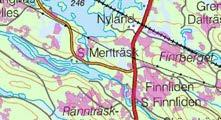



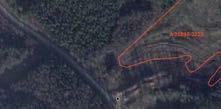
2. Field Work
This section describes the process of field investigation of the sites identified by methods described in the previous section. Six field trips were undertaken between August and December 2023. The steps taken at the visited logging sites were as follows:
1. If no timber piles were present, the field team documented the area, focusing on markings left by the logger in order to identify the company who carried out the operation.
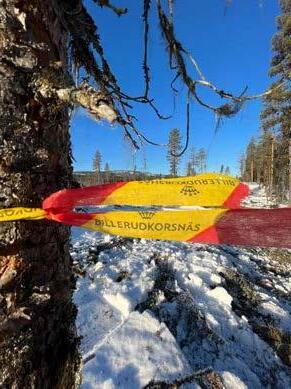
The company thus identified could then be contacted by email asking which facility received the timber from the logging site. It must be noted that the companies as a rule refused to provide this information. Only on one occasion did we receive an informative answer stating that no material from the logging in question went to a specific mill near the logging area.
2. If the investigating team arrived in the logging area when a timber truck was loading, the team followed the truck to its destination, documenting the loading, the landmarks along the way, and the facility that received the material.

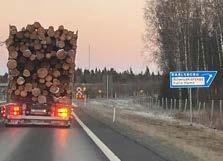
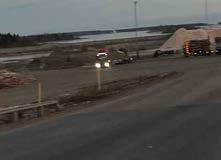

1 2 APPENDIX. KILLED BY CARDBOARD • NATURE CRIME FILES – DECLASSIFIED, SWEDEN APPENDIX. KILLED BY CARDBOARD • NATURE CRIME FILES– DECLASSIFIED, SWEDEN
Illustration, steps 1–5
Map of continuity forest superimposed on a section of the map in Västerbotten county. © Greenpeace
Intersection of logging notification with continuity forests. © Greenpeace
Result of further filtering – logging notification from less than one year ago inside continuity forests, excluding the areas that have been cleared more than a month earlier. © Greenpeace
One of a time series from Sentinel-2 satellite allowing the analysis of forest cover. © 2023 Copernicus/ESA
A high-resolution satellite image5 with timber piles visible next to the clear cut area. © 2023 Planet Labs PBC 18-Oct-2023
3. If the investigating team found timber piles but no timber truck, Bluetooth tracking devices were placed under the bark in the timber. Both iPhone (AirTag) and Android (SmartTag) compatible devices were used. The documentation was carried out by capturing the screenshot of the placement of the tags:
The signals from the trackers were then monitored on a near-daily basis. When the tracker responded with a new location, this was captured in a new screenshot.
The new location was analysed and documented with the help of GoogleMaps in order to determine the facility at the destination of the tracked timber.


Field work
Logging sites visited: 68.
Timber trucks followed from logging site to destination: 4.
Logging sites where trackers were placed: 23.
Number of trackers placed: 44 (22 SmartTags and 22 AirTags).
Trackers that sent a signal identifying destination of the timber: 24 (13 SmartTags and 11 AirTags).6



3 APPENDIX. KILLED BY CARDBOARD • NATURE CRIME FILES – DECLASSIFIED, SWEDEN
© Google
3. Documented Destinations
By visiting logging sites, following trucks and using tracking devices as described above, we were able to identify 9 pulp mills and 5 saw mills that received timber from 19 investigated logging sites in old-growth forests. Additionally, we identified 2 areas where there were indications of companies involved in the logging of old-growth areas.

Receiving company Facility location Certification Documented oldgrowth areas7 Documentation method
Ahlstrom Sweden AB Strandvägen 7, 666 41, Billingsfors
Billerud Sweden AB Karlsborg Bruk, Fabriksvägen 2, 952 83 Karlsborg
Holmen Iggesund Mill, Norra Kartonggatan, 825 80 Iggesund
FSC 8/PEFC A 24663-2023 SmartTag 2
FSC 9/PEFC A 29919-2023 A 30676-2023 AirTag 9 and SmartTag 4 Airtag 5 and Airtag 6
FSC 10 A 22250-2023 A 1485-2023 A 24885-2023 SmartTag 10 SmartTag 13 AirTag 18 and SmartTag 15
Holmen Hallsta paper mill, Tulkavägen 36, 763 34 Hallstavik A 30396-2023 AirTag 21
Metsä Board Husum Board and Pulp mill, Bruksvägen 86, 896 80 Husum
SCA Munksund Bruk, Munksundsvägen, 941 87, Piteå
SCA Obbola Paper Mill, Linjevägen 33, 913 42 Obbola
Smurfit Kappa Kolugnsvägen 30, 941 86 Piteå
FSC 11/PEFC A 47338-2023 SmartTag 9
FSC 12/PEFC A 2244-2023 SmartTag 6
FSC 13/PEFC A 40855-2023 Followed timber truck
FSC 14/PEFC A 25896-2023 A 25622-2023 Followed timber truck SmartTag 5
Stora Enso Skoghalls bruk, Bruksgatan, 663 30 Skoghall FSC 15 A 32615-2023 Email confirmation by the company
Table A2: Saw mills
Company name Facility location Products Certification Documented oldgrowth areas Documentation method
Fiskarheden Trävaru AB
780 68 Transtrand Sawn wood FSC 16/PEFC A 64194-2021 Company ID on machinery, confirmed via email correspondence with company
Ljungträ AB Vreta Munktorp, 731 70 Köping Spruce sawn wood up to 3m length PEFC A 56584-2022 AirTag 3
Stora Enso Gruvöns sawmill, Timmervägen 2, 664 33 Grums 17 Sawn wood, processed timber, pellets FSC A 58408-2022 Markings on wood piles, followed timber truck
Stora Enso Gruvöns sawmill, Timmervägen 2, 664 33 Grums Sawn wood, processed timber, pellets FSC A 32615-2023 Email communication from Stora Enso
SCA Timber AB Munksunds Sawmill, Måsvägen 20, 941 43 Piteå Sawn and planed pine 18 ? A 38672-2023 AirTag 22 and SmartTag 16
Indications
We also found indications of companies involved in the logging of investigated old-growth areas where timber has been removed. The indications of companies’ involvement are in the form of loggers’ markings (snitslingar) or in the form of information about the ownership of the forest. The data in the table below is only indicative, and does not constitute proof that the companies listed included the wood from these areas in their material flow.
Table A3. Indications
Possible receiver Documented oldgrowth areas
SCA (Closest facilities SCA Munksund pulp and saw mills in Piteå).
SCA (Closest facilities SCA Munksund pulp and saw mills in Piteå).
Documentation method
A 36105-2022 Marks on trees, located on SCA property. Information request regarding destination sent to SCA, final reply “I can not give out details of our flows"
A 37137-2023 Email response by a representative of the forest owner (Swedish Church) stated that the buyer of the timber “was SCA skog AB, they are the ones taking the timber and doing any potential certification.” SCA in turn refused to supply information about the destination of the timber.
5 6 APPENDIX. KILLED BY CARDBOARD • NATURE CRIME FILES – DECLASSIFIED, SWEDEN APPENDIX. KILLED BY CARDBOARD • NATURE CRIME FILES– DECLASSIFIED, SWEDEN
Table A1. Pulp mills
4. Documented Logging Sites with Links to Processors
The field investigation that entailed visits to over 68 clear-cut sites over the period of 7 months resulted in identification of 19 sites of clear-cut old growth forest that could be tracked to specific mills. The following section presents these findings, as well as, where known, the ownership of the logged forest as well as the name of the logging company.
Concession designation: A 24663-2023
Geographic location: North of Risviken, Värmland county.
Description: Potential continuity forest. Independent inventory identified multiple threatened species, including 30 instances of Goodyera repens , an orchid species protected under the Habitats directive. The inventory report concludes “ The notified logging contains old natural forest with clearly high biological values and clearly fulfils the definition of a Key Woodland Biotope.” 19
Destination: Ahlstrom Sweden AB. Privately owned. Logged by Hilmer Andersson.
Concession designation: A 29919-2023
Geographic location: 45 km West of Boden, Boden municipality, Norrbotten county.
Description: Probable continuity forest. 20
Destination: Billerud Sweden AB, Karlsborg pulp mill. Sveaskog owned and logged.

Concession designation: A 30676-2023
Geographic location: West of Sangis, Kalix municipality, Norrbotten county.
Description: Probable continuity forest.
Destination: Billerud Sweden AB, Karlsborg pulp mill. Privately owned. Logged by Billerud.

Greenpeace

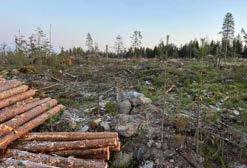
Concession designation: A 22250-2023
Geographic location: L jusdal municipality, Gävleborg county.
Description: Probable and potential continuity forest. 20
Inside a high natural value landscape (värdetrakt).
Destination: Holmen, Iggesund pulp mill. Sveaskog owned and logged.

Concession designation: A 1485-2023
Geographic location: Hudiksvall municipality, Gävleborg county.
Description: Probable and potential continuity forest. Logs from trees over 150 years old.
Destination: Holmen, Iggesund pulp mill. Privately owned. Logged by Holmen.

Concession designation: A 24885-2023
Geographic location: Hudiksvall municipality, Gävleborg county.
Description: Probable and potential continuity forest. Inside a high natural value forest landscape (värdetrakt).
Destination: Holmen, Iggesund pulp mill. Privately owned. Logged by Holmen.
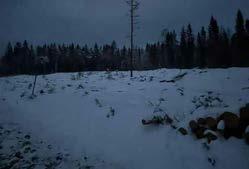
Concession designation: A 30396-2023
Geographic location: Hudiksvall municipality, Gävleborg county.
Description: Probable and potential continuity forest. Inside a high natural value forest landscape (värdetrakt). Contains a forest value core (värdekärna). 22
Destination: Holmen, Hallsta pulp mill. Privately owned. Logged by Holmen.
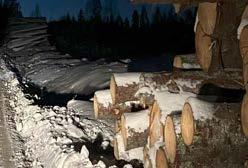
7 8 APPENDIX. KILLED BY CARDBOARD • NATURE CRIME FILES – DECLASSIFIED, SWEDEN APPENDIX. KILLED BY CARDBOARD • NATURE CRIME FILES– DECLASSIFIED, SWEDEN
©
© Greenpeace
© Greenpeace
© Greenpeace
© Greenpeace
© Greenpeace
© Greenpeace
Concession designation: A 47338-2023
Geographic location: Krokom municipality, Jämtland county.
Description: Probable and potential continuity forest.
Destination: Metsä Board, Husum board and pulp mill. Privately owned. Logged by Norra Skog.

Concession designation: A 2244-2023
Geographic location: Gällivare municipality, Norrbotten county.
Description: Probable continuity forest and probable affected continuity forest.
Destination: SCA Munksund pulp mill. Privately owned. Logged by Billerud.
Concession designation: A 40855-2023
Geographic location: Umeå municipality, Västerbotten county.
Description: Probable continuity forest. Piles contain timber from 150 years old trees.
Destination: SCA Obbola pulp mill. Ownership unclear. Logged by Holmen
Concession designation: A 25896-2023
Geographic location: Piteå municipality, Norrbotten county.
Description: Probable continuity forest. Piles with timber between 150 and 200 years. In vicinity reported sightings of hazel grouse ( Tetrastes bonasia , nearly threatened), and redwing ( Turdus iliacus , nearly threatened, protected in accordance with Birds directive). Both species are negatively affected by clear-cut logging. 20
Destination: Smurfit Kappa. Privately owned. Logged by Sveaskog.

Concession designation: A 25622-2023
Geographic location: Boden municipality, Norrbotten county.
Description: Probable continuity forest. 20
Destination: Smurfit Kappa. Sveaskog owned and logged.
Greenpeace
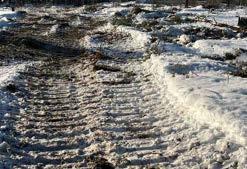
Greenpeace
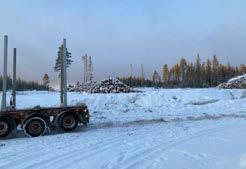
Greenpeace
Concession designation: A 64194-2021
Geographic location: Leksand municipality, Dalarna county.
Description: Probable continuity forest. A Calcareous Coniferous Forests. 23 The forest contained over thirty sightings of 26 different threatened and protected species, as well as of 23 signal species (species that are found in old-growth forests). Complaints were filed with the Forest Agency, environmental courts and the FSC, the forest was logged despite these.
Destination: Fiskarheden sawmill. Privately owned. Logged by Fiskarheden.
Concession designation: A 56584-2022
Geographic location: Kristinehamn municipality, Värmland county.
Description: Potential continuity forest. Seven redlisted bird species noted in the vicinity, including Great Grey Owl ( Strix nebulosa , vulnerable status, protected under Annex 1 of the EU Birds directive). According to the Swedish species data bank “The most serious threat is the reduction of the availability of suitable breeding environments and especially of nesting environments due to forestry.” 24 20
Destination: Ljungträd AB sawmill. Sveaskog owned and logged.
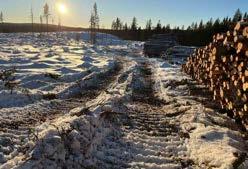

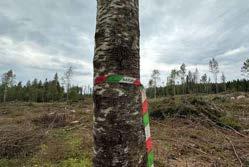

Concession designation: A 58408-2022
Geographic location: Arvika municipality, Värmland county.
Description: Potential continuity forest. Partially inside a high natural value forest landscape (värdetrakt).
Greenpeace
Destination: Stora Enso Gruvön sawmill. Privately owned (?). Logged by Stora Enso. ©
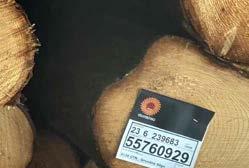
9 10 APPENDIX. KILLED BY CARDBOARD • NATURE CRIME FILES – DECLASSIFIED, SWEDEN APPENDIX. KILLED BY CARDBOARD • NATURE CRIME FILES– DECLASSIFIED, SWEDEN
©
©
©
©
© Greenpeace
© Greenpeace
© Greenpeace
Greenpeace
Concession designation: A 38672-2023
Geographic location: Norsjö municipality, Västerbotten county.
Description: Probable continuity forest. Reported sightings of otters ( Lutra lutra, nearly threatened). Reported sightings of 3 nearly threatened bird species.
Destination: SCA Timber, Munksund sawmill. Privately owned. Logged by SCA

Concession designation: A 32615-2023
Geographic location: Arvika municipality, Värmland county.
Description: Potential continuity forest. Independent inventory identified three threatened species, including Goodyera repens an orchid species protected under the Habitats directive. 25
Destination: Stora Enso Skoghall pulp mill, Stora Enso Gruvön sawmill. Privately owned, logged by Stora Enso.
Concession designation: A 36105-2022
Geographic location: Kalix municipality, Norrbotten county.
Description: Probable continuity forest and potential continuity forest.
Destination: Unknown. Information requested sent to the owner/logger who also operates facilities in the area. The company refused to provide this information. Owned and logged by SCA.

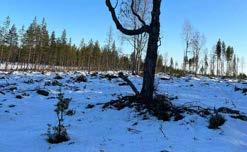
Concession designation: A 37137-2023
Geographic location: Malå municipality, Norrbotten county.
Description: Probable continuity forest. Independent field biology inventory found 4 red-listed species in the area, including Diamond Willow Fungus ( Haploporus odorus , a vulnerable species, and a signal species for old-growth forests).
Destination: Unknown. Email response by a representative of the forest owner (Swedish Church) stated that the buyer of the timber “was SCA Skog AB, they are the ones taking the timber and doing any potential certification.” SCA in turn refused to give information about the destination of the timber. Owned by Church of Sweden, logged by SCA.
Part 2 Mills to Markets – Investigation Methodology and Results
1. Swedish Paper to European Corrugated Cardboard
The following section lists companies that produce corrugated cardboard packaging and where Greenpeace Nordic holds evidence that they are buying kraftliner from Swedish pulp and paper producers linked to the clear-cutting of old-growth forests.
Table A4: Customers of kraftliner produced by Swedish paper mills identified to source fibre from clear-cutting old-growth in Sweden
Supplier Customer Customer headquarter Source
Smurfit Kappa Schumacher Packaging Germany
SCA Schumacher Packaging Germany Kraftliner reels from Smurfit Kappa and SCA (and Finish Metsä Board) documented at the Schumacher Ebersberg plant in early 2024, Figure A1. Also see images of SCA kraftliner reels, uploaded to Google Maps in August 2020 and March 2021
SCA DS Smith UK FSC kraftliner reels from SCA Munksund mill, documented at the DS Smith Porcari mill (Italy) in early 2024, Figure A2.
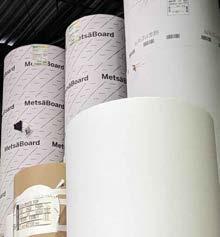
Greenpeace


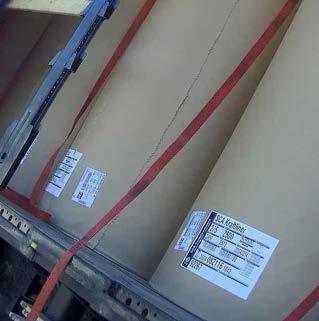
11 APPENDIX. KILLED BY CARDBOARD • NATURE CRIME FILES – DECLASSIFIED, SWEDEN
© Greenpeace
© Greenpeace
© Greenpeace
©
Figure A1. Kraftliner reels at Schumacher Ebersberg plant, 2024.
Figure A2. Kraftliner reels at DS Smith Porcari plant, 2024.
2. Customers of Swedish Paper and Paperboard Producers
The following table lists companies, where supplier’s websites and publications, or markings on actual products suggest current or recent links to those Swedish pulp & paper producers that our research has linked to the clear-cutting of old-growth forests.
The information in this table is either based on claims made by supplier companies on their websites and in their publications (annual reports, investor presentations, etc.) or through markings found on actual

products, that identify the producer of the packaging26 of a given consumer product (e.g. the FSC label). Links clearly pre-dating 2020 have been omitted. A company being listed here means that they have a risk in their supply chain of sourcing fibre from clear-cutting of continuity forests in Sweden. It does not mean that they are proven to receive fibre from those clearcuts through the products they source from any given supplier.
A limited number of third party paper converters has been listed, where direct evidence of paper purchases from any of the Swedish mills is available (see Table A4 above).
Table A5: List of consumer goods companies identified to be at risk of sourcing fibre from clear-cutting old-growth in Sweden
Supplier Customer Customer headquarter Source*
Billerud Nestlé S.A. Switzerland Nestlé supply chain disclosure: pulp mills , 2022
Billerud Tetra Pak Group Switzerland BillerudKorsnäs 2020 Annual Report (p9)
DS Smith Beiersdorf AG Germany Company logo
DS Smith Bonduelle SA France DS Smith website
DS Smith Leksands Knäckebröd AB Sweden Company logo
DS Smith Luigi Lavazza s.p.a. Italy Company logo
DS Smith Mondelez International, Inc. US Company logo
DS Smith Procter & Gamble Company US P&G’s paper packaging suppliers list , March 2023
DS Smith Samsung Electronics South Korea FSC code
DS Smith Zalando SE Germany DS Smith website
Holmen Henkel AG & Co. KGaA Germany Industry Magazine , online
Metsä Board Nestlé S.A. Switzerland Nestlé supply chain disclosure: pulp mills , 2022
Metsä Board Unilever plc United Kingdom Metsä website
SCA Nestlé S.A. Switzerland Nestlé supply chain disclosure: pulp mills , 2022
Schumacher Packaging Amazon.com, Inc. US Resy number
Schumacher Packaging Henkel AG & Co. KGaA Germany Schumacher website
Schumacher Packaging Lorenz Bahlsen Snack-World Germany Schumacher website ; Resy code
Supplier Customer Customer headquarter Source*
Schumacher Packaging Philips, Koninklijke N.V Netherlands FSC Code
Schumacher Packaging Procter & Gamble Company US P&G’s paper packaging suppliers list , March 2023
Schumacher Packaging Robert Bosch GmbH Germany Schumacher website
Smurfit Kappa Aldi Nord Germany Company logo
Smurfit Kappa Amazon.com, Inc. US Resy code
Smurfit Kappa Anheuser-Busch InBev Belgium Smurfit Kappa website
Smurfit Kappa Arla Foods amba Denmark Smurfit Kappa website
Smurfit Kappa Bertolli Italy Company logo
Smurfit Kappa United Biscuits France (Pladis) France Smurfit Kappa website
Smurfit Kappa Robert Bosch GmbH Germany Smurfit Kappa website
Smurfit Kappa Carrefour France Smurfit Kappa website
Smurfit Kappa Coca-Cola Company US Company logo
Smurfit Kappa Crisp B.V. Netherlands Smurfit Kappa website
Smurfit Kappa Danone S.A. France Smurfit Kappa Sustainable Development report 2022
Smurfit Kappa Davo Bieren B.V. Netherlands Smurfit Kappa website
Smurfit Kappa dm-drogerie markt GmbH Germany FSC code
Smurfit Kappa Dole Plc Ireland Smurfit Kappa website
Smurfit Kappa Domino’s Pizza, Inc. US FSC code
Smurfit Kappa Dryk Aps Denmark Company logo
Smurfit Kappa ebay Inc. US Smurfit Kappa website
Smurfit Kappa Royal FrieslandCampina N.V. Netherlands Company logo
Smurfit Kappa Groupe Lactalis France Smurfit Kappa website ; Company logo
Smurfit Kappa Granarolo S.p.a. Italy Company logo
Smurfit Kappa HelloFresh SE Germany FSC code
Smurfit Kappa Henkel AG & Co. KGaA Germany Company logo
Smurfit Kappa Intersnack Group GmbH & Co. KG Germany Smurfit Kappa website
Smurfit Kappa Pilgrim’s Food Masters United Kingdom Smurfit Kappa website
Smurfit Kappa Kimberly Clark Co. US Smurfit Kappa website
Smurfit Kappa L’Oréal S.A France Smurfit Kappa website
Smurfit Kappa Lactalis International France Smurfit Kappa website
Smurfit Kappa Lidl Stiftung & Co. KG Germany Smurfit Kappa website
Smurfit Kappa Mars Inc. US Smurfit Kappa website 1 and 2
13 14 APPENDIX. KILLED BY CARDBOARD • NATURE CRIME FILES – DECLASSIFIED, SWEDEN APPENDIX. KILLED BY CARDBOARD • NATURE CRIME FILES– DECLASSIFIED, SWEDEN

Supplier Customer Customer headquarter Source*
Smurfit Kappa mymuesli AG Germany Smurfit Kappa website (video)
Smurfit Kappa MUTTI S.P.A. Italy Company logo
Smurfit Kappa Nestlé S.A. Switzerland Smurfit Kappa website 1 and 2 ; Nestlé supply chain disclosure: pulp mills , 2022
Smurfit Kappa Netto Marken-Discount (Edeka Group) Germany FSC code
Smurfit Kappa Oatly Group AB Sweden Company logo
Smurfit Kappa OBI GmbH & Co Deuschland KG Germany FSC code
Smurfit Kappa Pepsico Inc. US Smurfit Kappa website , Supplier of the year 2023
Smurfit Kappa Philips, Koninklijke N.V Netherlands Smurfit Kappa website
Smurfit Kappa Procter & Gamble Company US P&G’s paper packaging suppliers list , March 2023
Smurfit Kappa Samsung Electronics South Korea FSC code
Smurfit Kappa SC Johnson US Company logo
Smurfit Kappa Segafredo Zanetti S.p.a Italy Smurfit Kappa website
Smurfit Kappa Staples Inc. US Smurfit Kappa website
Smurfit Kappa Unilever Plc United Kingdom Unilever’s Paper and Board Suppliers 2022
Smurfit Kappa Upfield Europe BV Netherlands Smurfit Kappa website
Smurfit Kappa VF Corporation (North Face) US Smurfit Kappa website
Smurfit Kappa Zalando SE Germany Smurfit Kappa website
Stora Enso Arla Foods Amab Denmark Stora Enso website
Stora Enso Delicato bakverk AB Sweden Stora Enso website
Stora Enso Elopak AS Norway Stora Enso website
Stora Enso Four North Stockholm AB Sweden Stora Enso website
Stora Enso Greenfood AB Sweden Stora Enso website
Stora Enso Liba Bröd AB Sweden Stora Enso website
Stora Enso Lidl Stiftung & Co. KG Germany Stora Enso/DeJong website
Stora Enso LVMH Moët Hennessy Louis Vuitton France Stora Enso website
Stora Enso Nestlé S.A. Switzerland Nestlé supply chain disclosure: pulp mills , 2022
Stora Enso Outmeals AB Sweden Stora Enso website
Stora Enso Robert Bosch GmbH Germany Stora Enso website
Stora Enso SIG (Combibloc) Group AG Switzerland SIG Annual Report 2023
Stora Enso Svenska Krämfabriken AB Sweden Stora Enso website
Supplier Customer Customer headquarter Source*
Stora Enso Tetra Pak Group Switzerland Stora Enso website
Stora Enso Unilever PLC United Kingdom Stora Enso website
Upfield Netherlands Upfield, Paper Mill lists – Updated in January 2022
Stora Enso Zalando SE Germany FSC code
* On the given references:
Resy code: Resy is a certification scheme that claims to guarantee the recycling of corrugated cardboard products. Member companies receive a unique number that is to be printed on their products together with the Resy logo. These numbers identify the producer of the given product.
FSC code: FSC is a certification scheme that claims to ensure that certified products originate from sustainable forestry. Certified companies receive a unique number to print on their products together with the FSC logo. These numbers identify the producer of the given product.
Company logo: The company’s logo or name appears on the packaging product.
Images of products of the listed companies, showing the Resy and/or FSC code can be provided on request.
15 16 APPENDIX. KILLED BY CARDBOARD • NATURE CRIME FILES – DECLASSIFIED, SWEDEN APPENDIX. KILLED BY CARDBOARD • NATURE CRIME FILES– DECLASSIFIED, SWEDEN
Images of packaging products made by companies who source from paper mills linked to the destruction of oldgrowth forests in Sweden.
© Greenpeace, 2023-2024








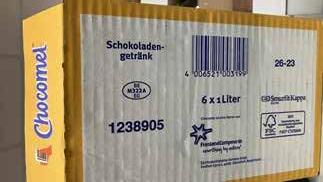
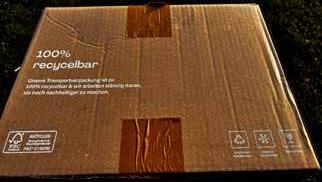
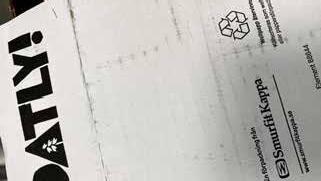






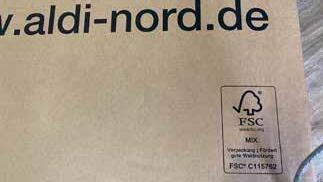



appendix Endnotes

1 Naturvårdsverket (2023). Continuity Forests data, Geodata portal of the Swedish Environmental Protection Agency (c), accessed Nov 2023
2 Skogsstyrelsen (undated). Logging Notifications Data , Geodata portal of the Swedish Forest Agency, accessed throughout 2023 and 2024 YTD
3 Skogsstyrelsen (undated). Completed Logging Data , Geodata portal of the Swedish Forest Agency, accessed throughout 2023 and 2024 YTD
4 EU Copernicus (2023). Sentinel On-Line , European Union database, accessed throughout 2023
5 © 2023 Planet Labs PBC 18-Oct-2023
6 The choice of using Smart- and AirTags rather than commercially available GPS trackers was dictated by the battery life of the devices. The tags are less dependable than GPS trackers, since they need a nearby Bluetooth device of the same manufacturer in order to react and send the current coordinates. If no such device is present, the tag will not react. About 50% of the tags placed in timber during investigation never returned a new position. This could mean either that the timber was still at the logging sites, or that the stock with the embedded tracker was never close enough to a device of the same manufacturer with the Bluetooth on. The trackers will continue to be monitored until the batteries are exhausted.
7 The logging areas are identified by the designation number assigned by the Swedish Forest Agency to the logging notifications. The exact geolocation and some additional information about the areas can be obtained by requesting documentation for each site from the Agency, or downloading the GIS map layer from: Skogsstyrelsen (2023/2024), Logging Notifications Data , Geodata portal of the Swedish Forest Agency
8 DNV (2023). FSC ® CHAIN OF CUSTODY CERTIFICATE, Ahlstrom AB , DNV Business Assurance Sweden AB, Jan 23, 2023
9 FSC certificates for Billerud Karlsborg Mill: SGSCH-COC-000091/SGSCH-CW-000091
10 FSC certificate for Holmen Iggesund Paperboard: SA-COC-012971
11 FSC certificates for Metsä Board Husum: INS-COC-100100/INS-CW-100100
12 FSC certificates for SCA Munksund Mill: BV-COC-013162/ BV-CW-013162
13 FSC certificates for SCA Obbola Mill: BV-COC-013162/ BV-CW-013162
14 FSC certificates for Smurfit Kappa Kraftliner Piteå: DNV-COC-000118/DNV-CW-000118
15 FSC certificates for Stora Enso: INS-COC-100054/INS-CW-100054
16 FSC certificate for Fiskarheden: SCS-COC-000708
17 Stora Enso (undated). Gruvöns sågverk website, accessed March 2024
18 SCA (undated). Our units , website, accessed March 2024
19 Kirppu, S. (2022). Avverkningsplanerad barrnaturskog med höga biologiska värden norr om Risviken (unpublished). Copy available upon request.
20 In a pre-publication comment to Greenpeace, Sveaskog claimed that the forest is not a continuity forest, despite the fact that it is clearly identified as such in the mapping layer of continuity forests published by the Swedish EPA
21 “ Nature that contains high densities of value cores, that is, slightly larger areas with several value cores and with high natural values, are called value landscapes” in Naturvårdsverket (2023), Frågor och svar om grön infrastruktur Swedish Environmental Protection Agency, Dec 15, 2023
22 “Areas called value cores are interconnected, smaller natural areas with high natural values of a certain nature type” in Naturvårdsverket (2023) Frågor och svar om grön infrastruktur Swedish Environmental Protection Agency, Dec 15, 2023
23 “Calcareus coniferous forests make up some of our most endangered, rare and at the same time species-rich habitat types…Their protection and management are of great importance for the overall objective of preserving forest biodiversity... Many of the threatened species that are adversely affected by logging are dependent on long forest continuity” Skogsstyrelsen (2022) Levande skogar Fördjupad utvärdering 2023 , The Swedish Forest Agency, Sep 2022
17 18 APPENDIX. KILLED BY CARDBOARD • NATURE CRIME FILES – DECLASSIFIED, SWEDEN APPENDIX. KILLED BY CARDBOARD • NATURE CRIME FILES– DECLASSIFIED, SWEDEN

24 SLU (2024). Artfakta: Strix nebulosa , Swedish Species Information Centre, Swedish University of Agricultural Sciences (SLU), accessed Apr 18, 2024
25 Adolfsson, R. (2023). Rapport ang. avverkningsanmälan A32615-2023 (unpublished, submitted to Swedish Forest Agency (Skogsstyrelsen), copy can be provided upon request)
26 Packing here can mean the actual product packaging or the shelf-ready shipping box for the respective product.
19 APPENDIX. KILLED BY CARDBOARD • NATURE CRIME FILES – DECLASSIFIED, SWEDEN











































































